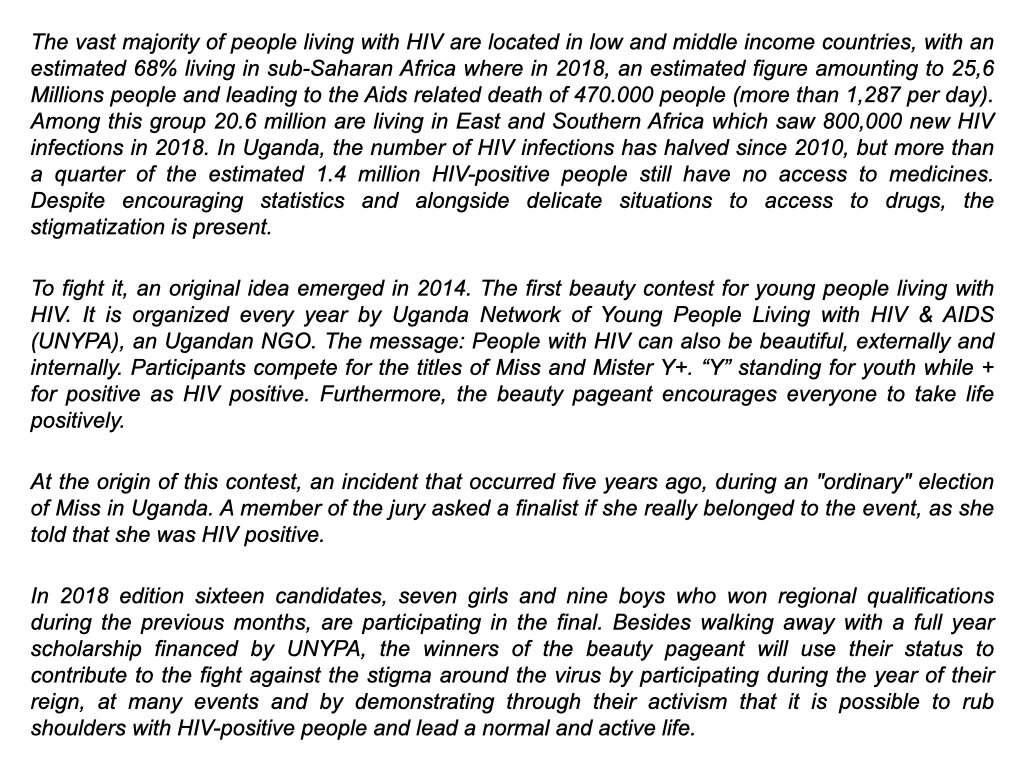
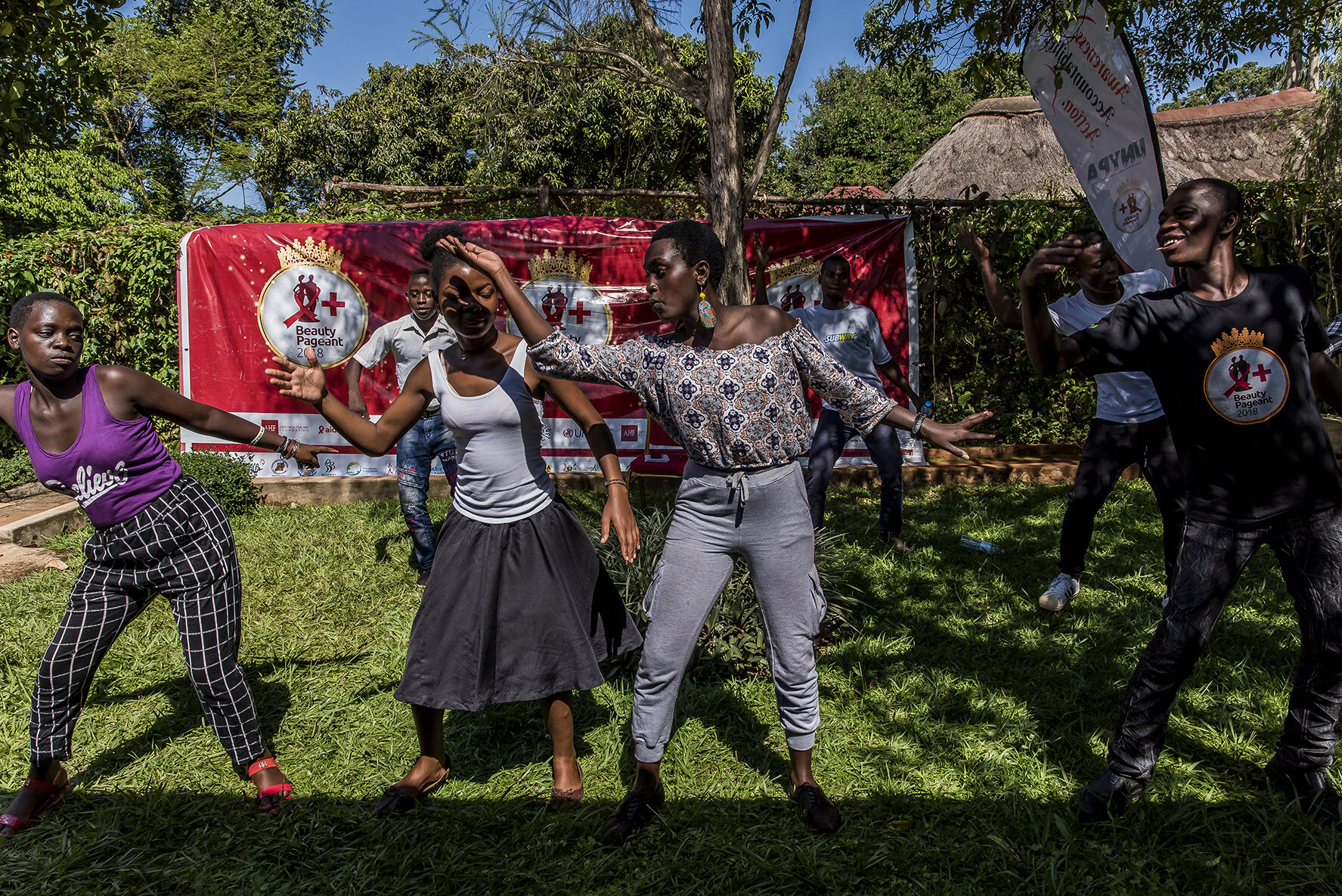
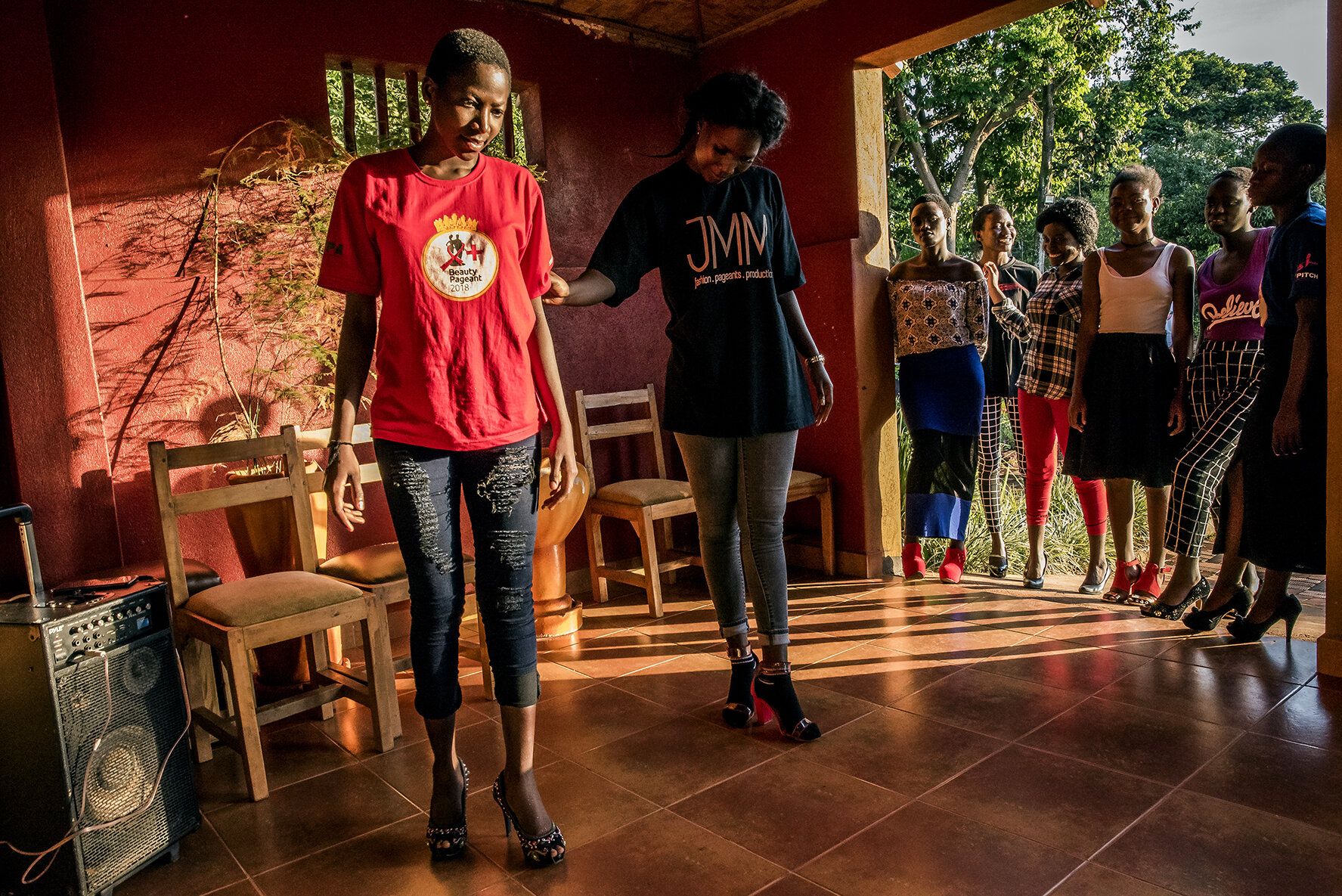
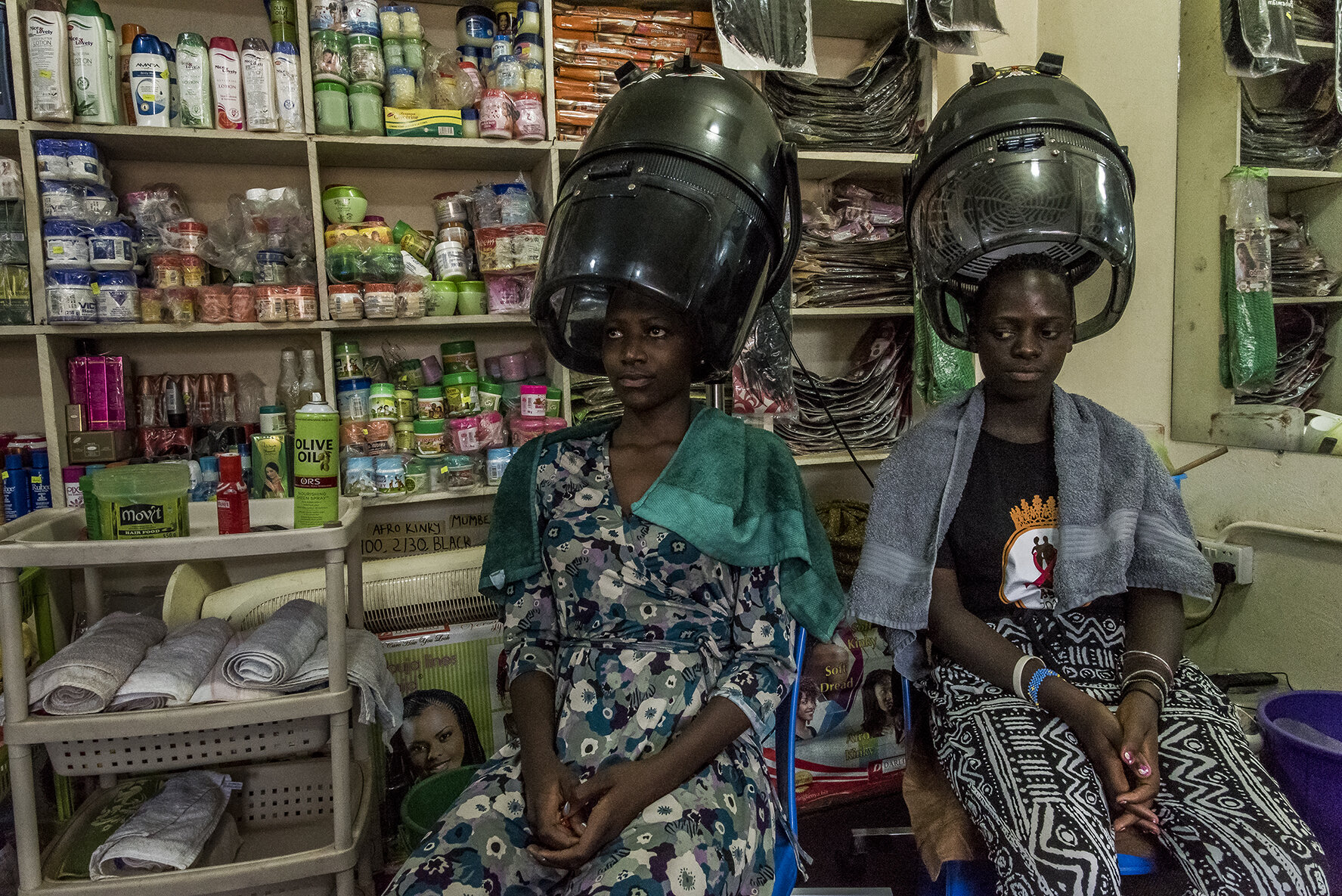
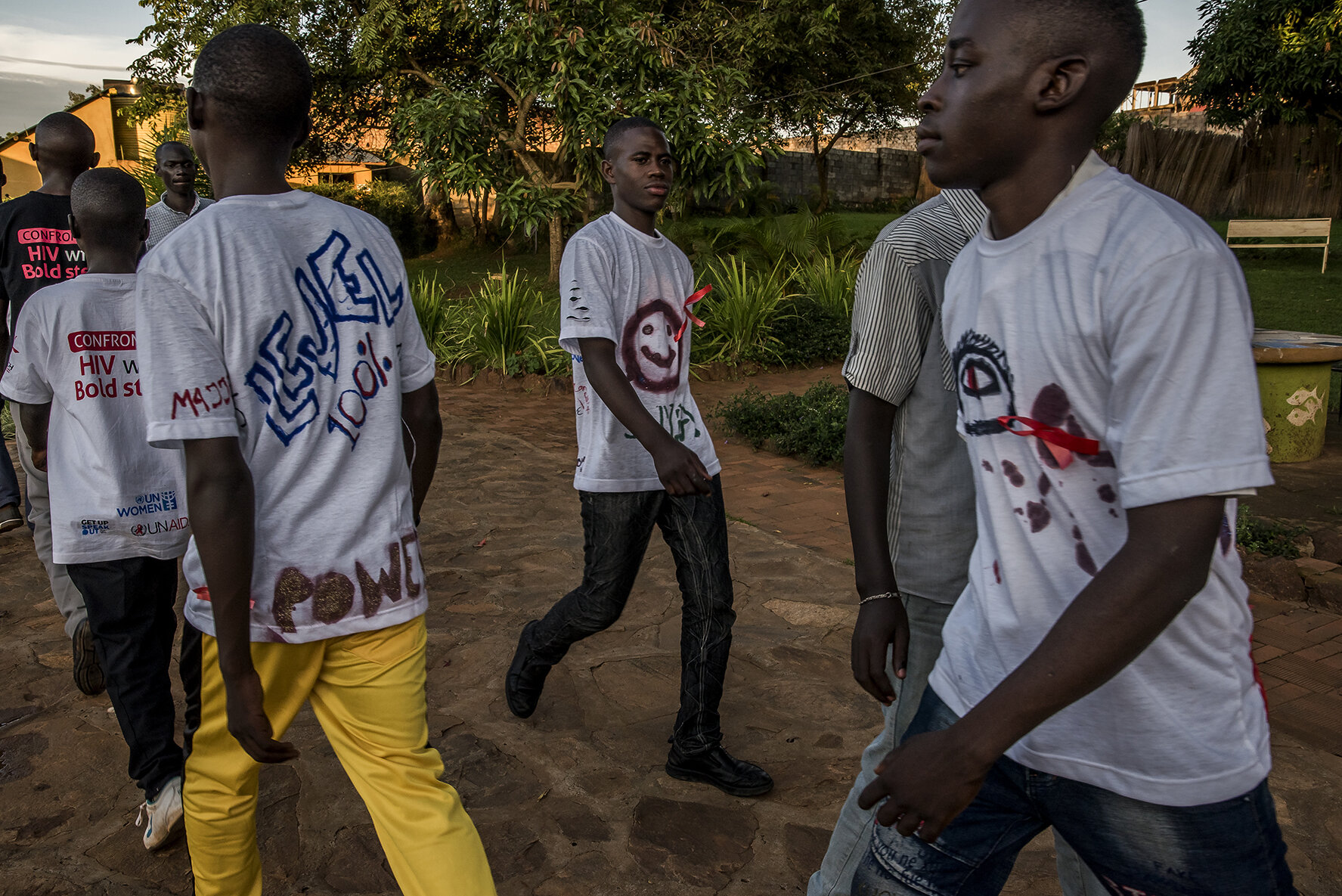
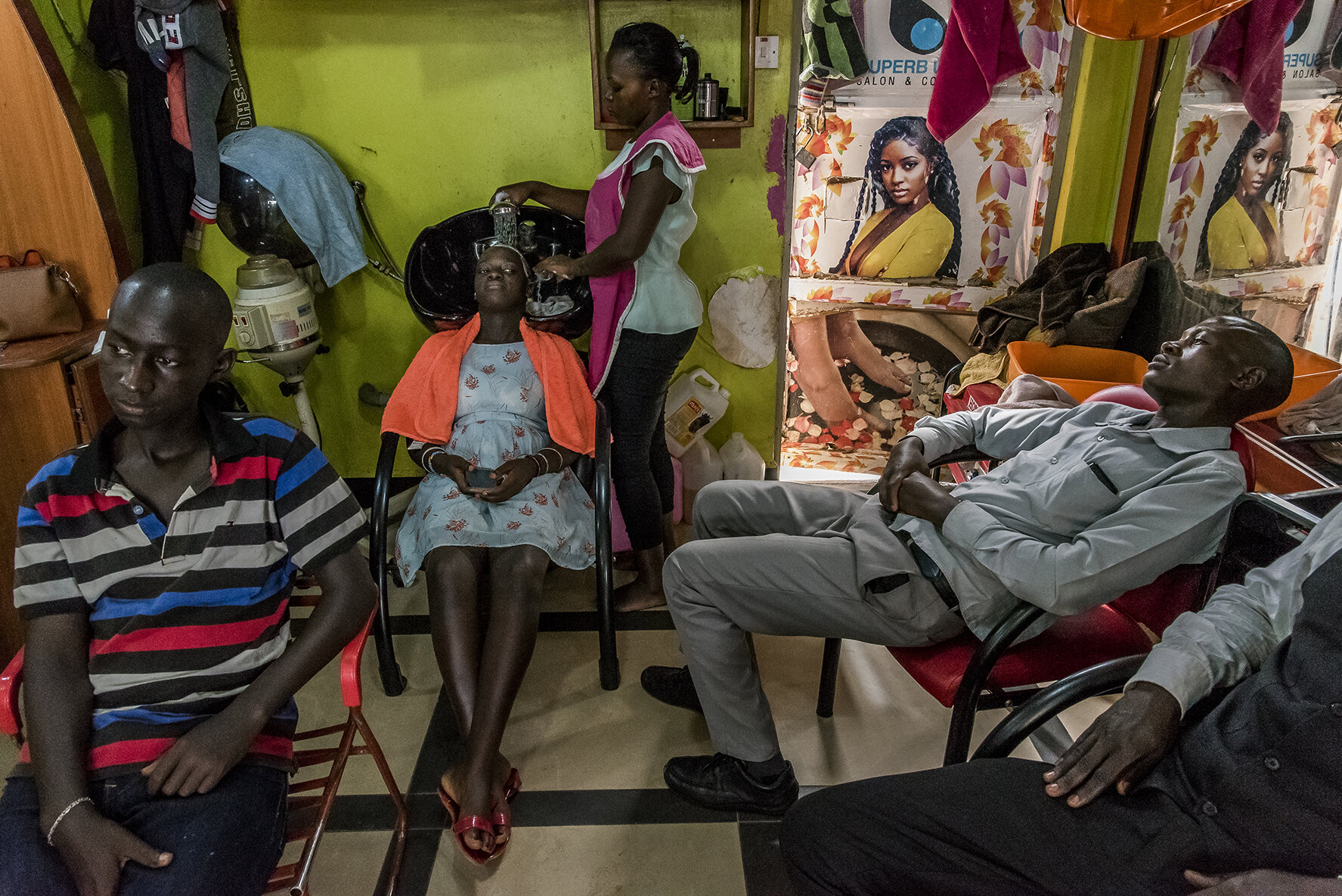
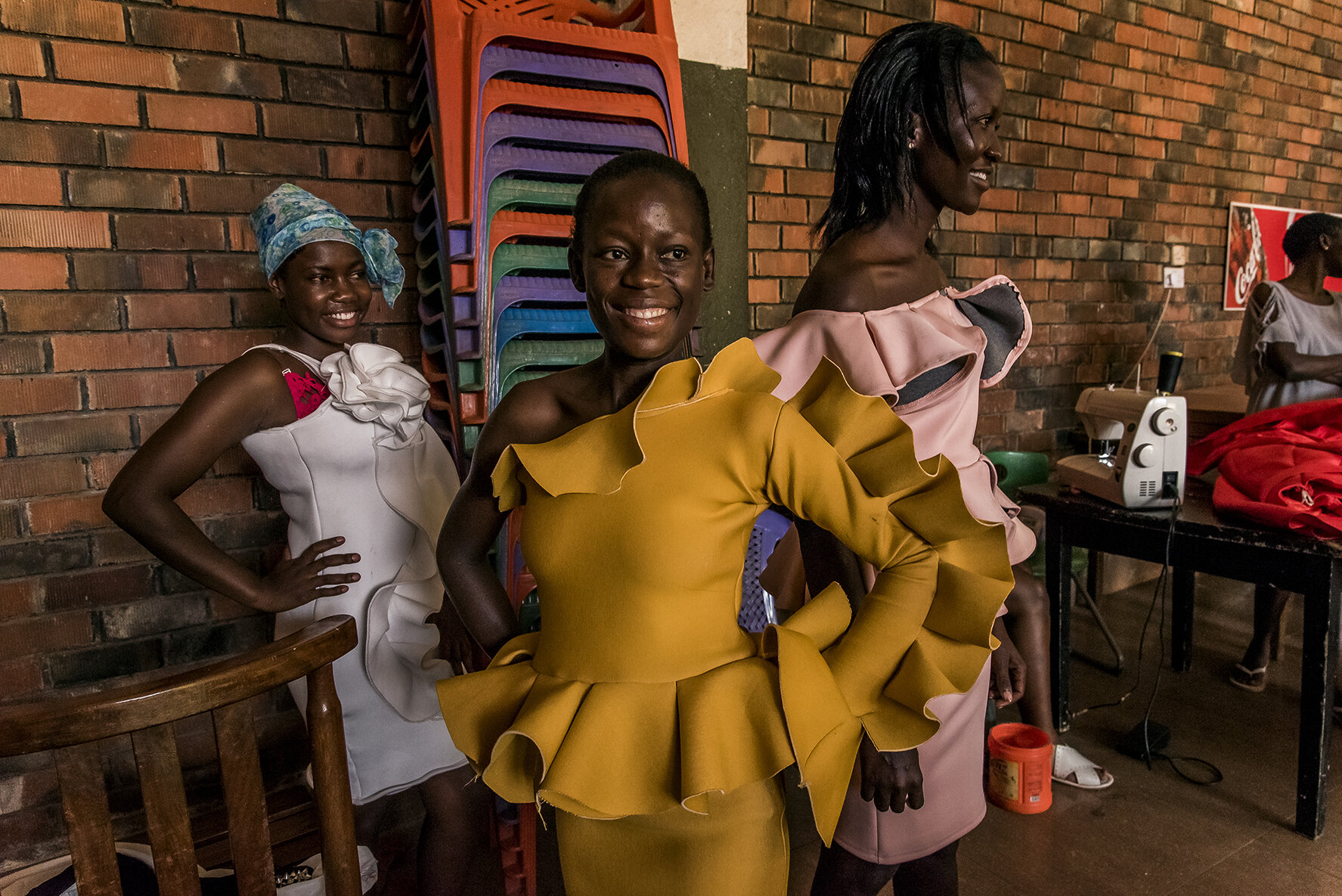
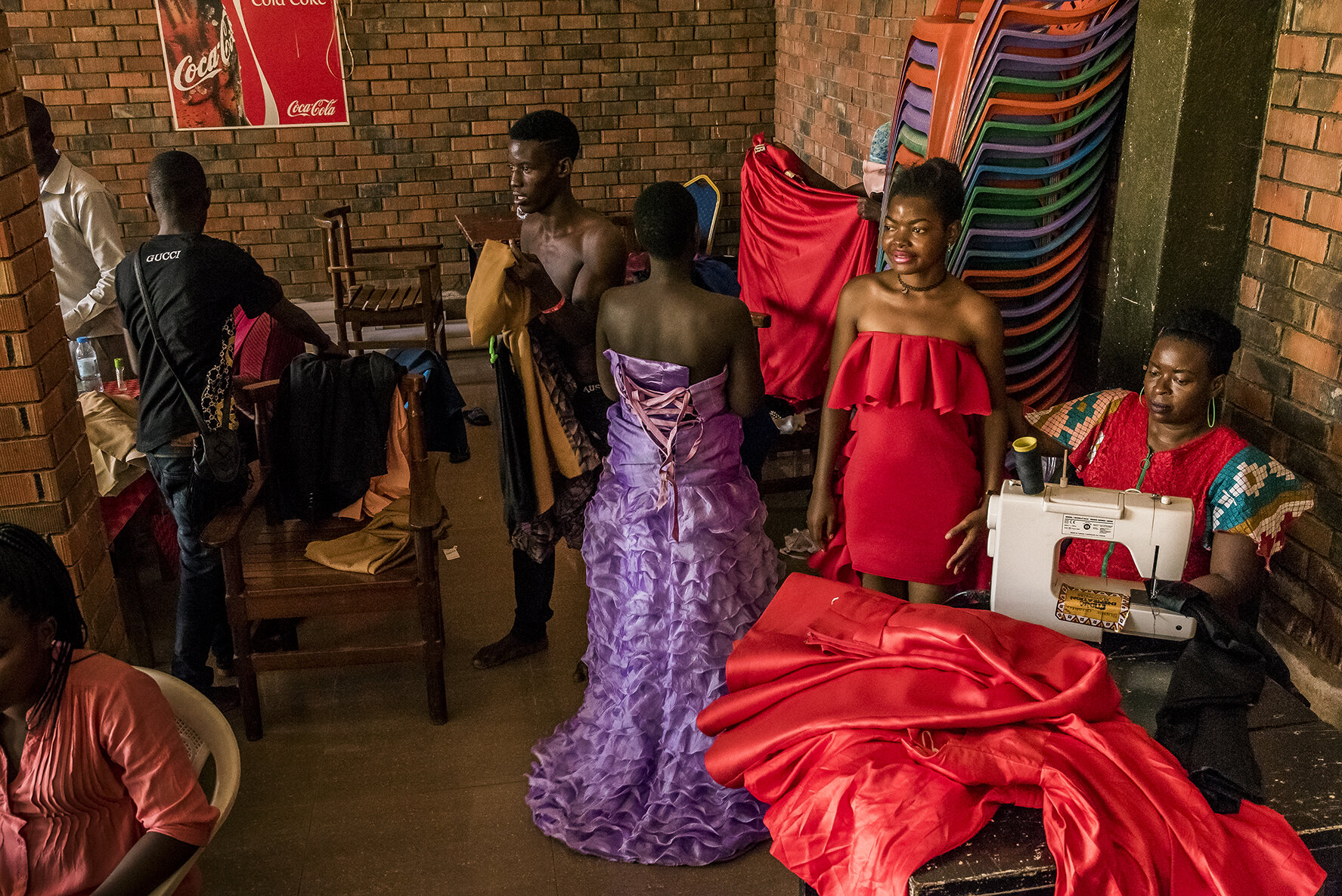
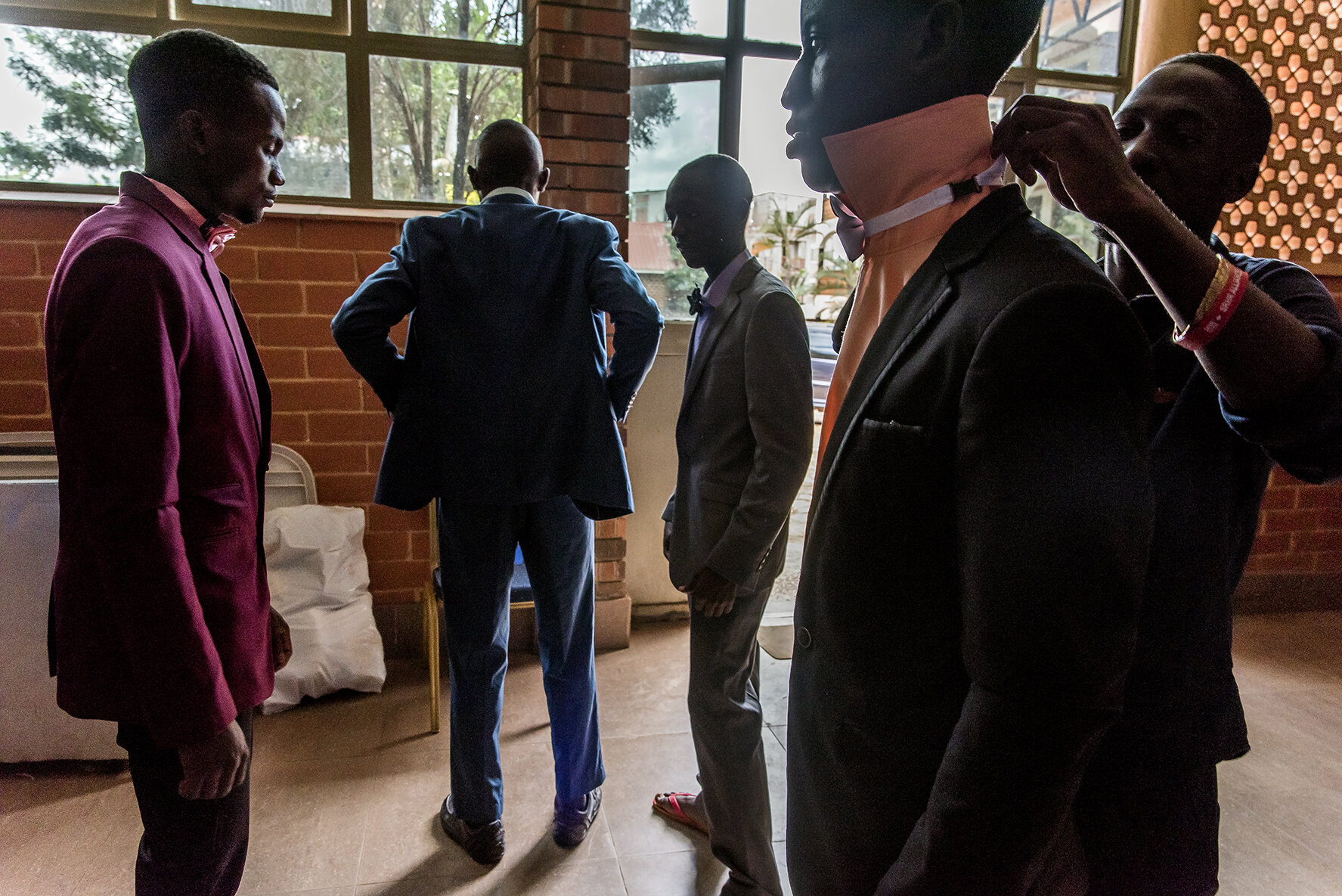

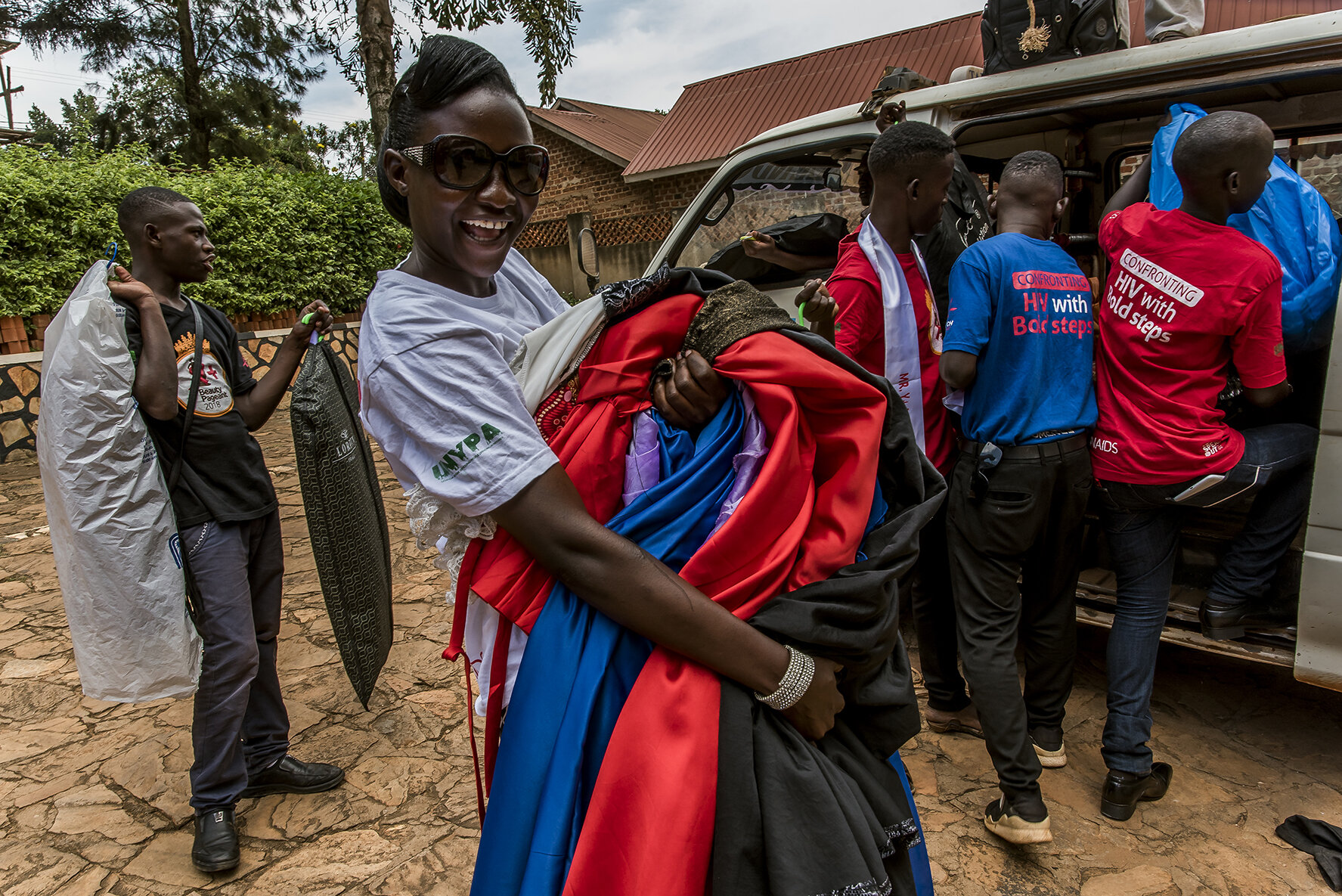

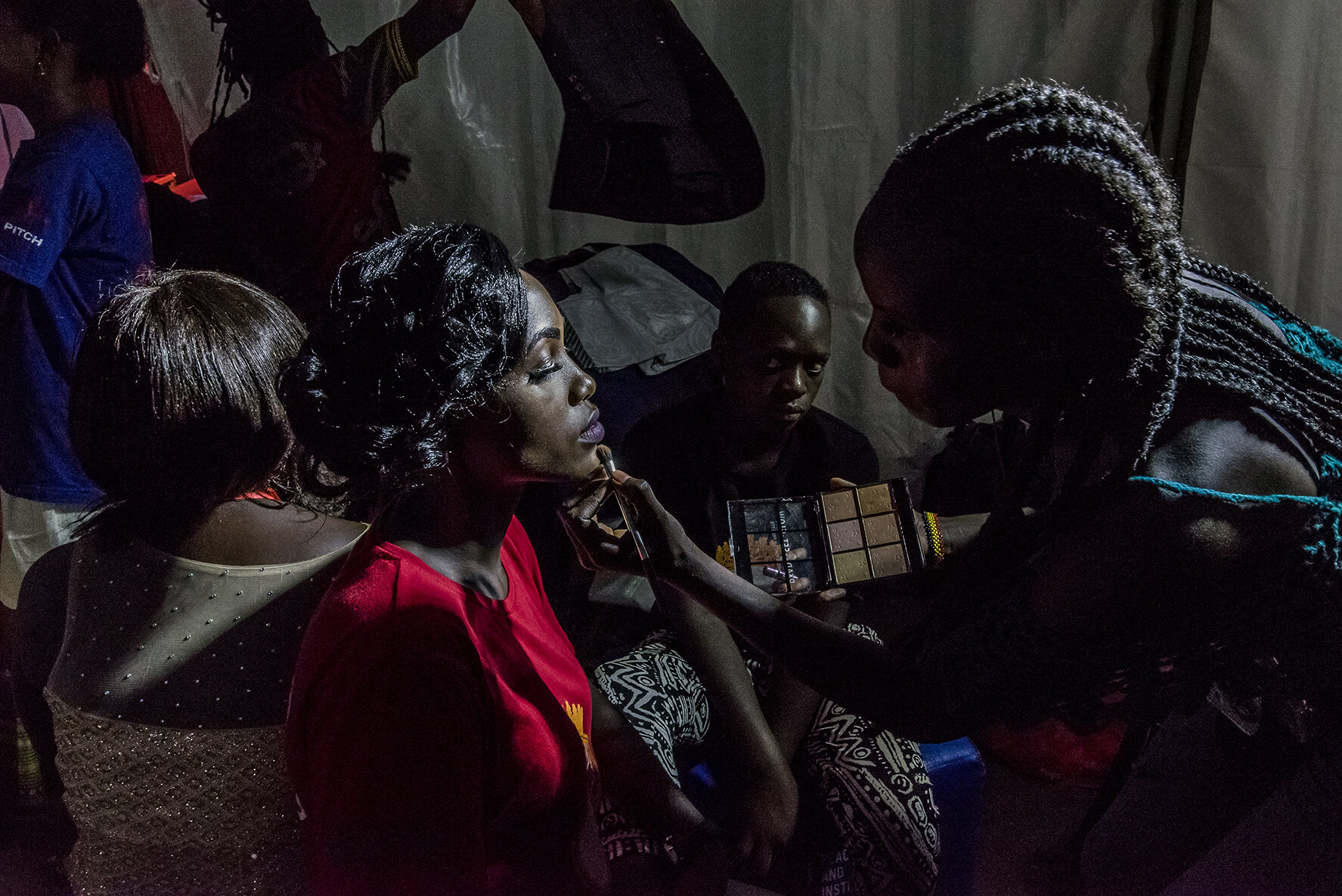

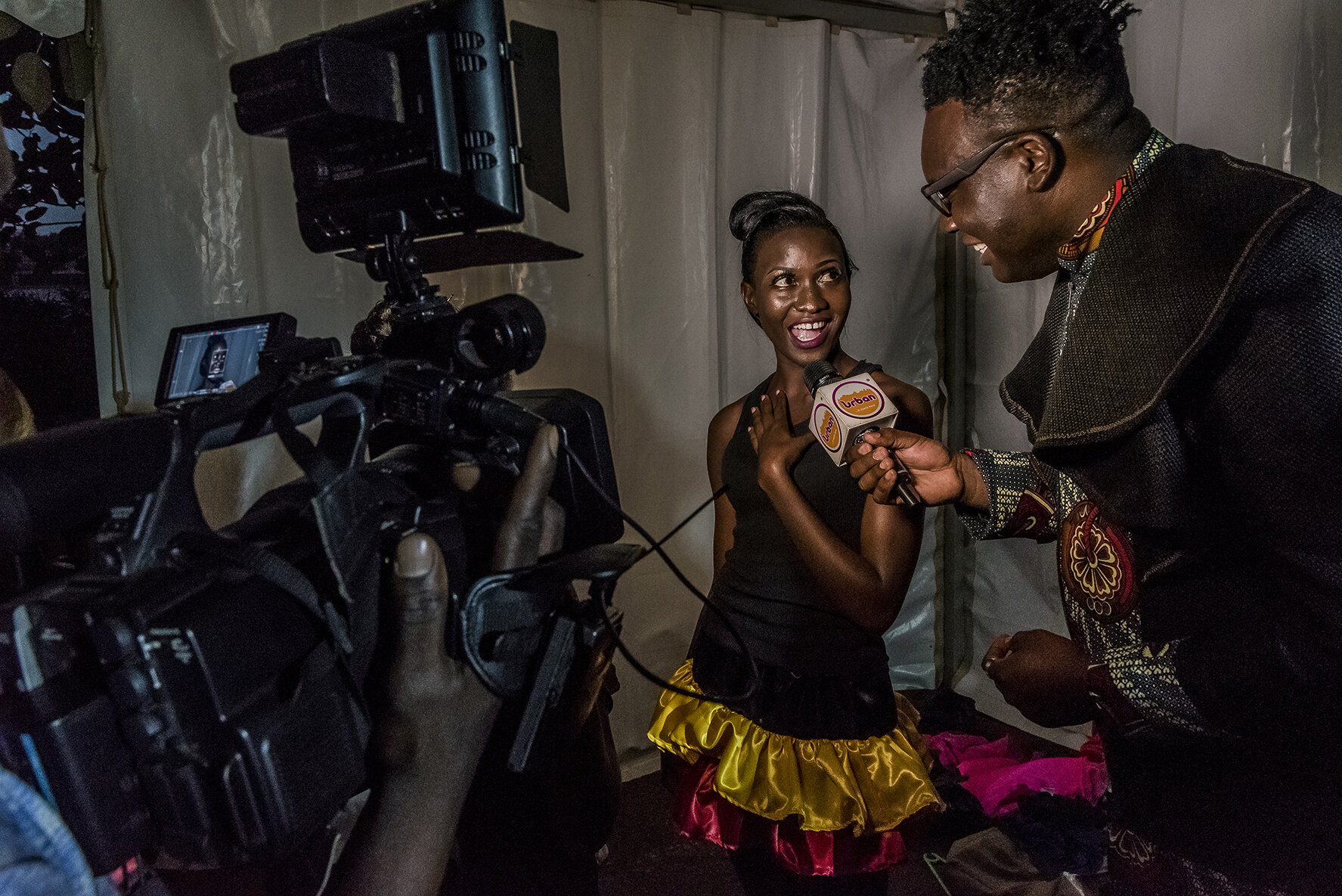
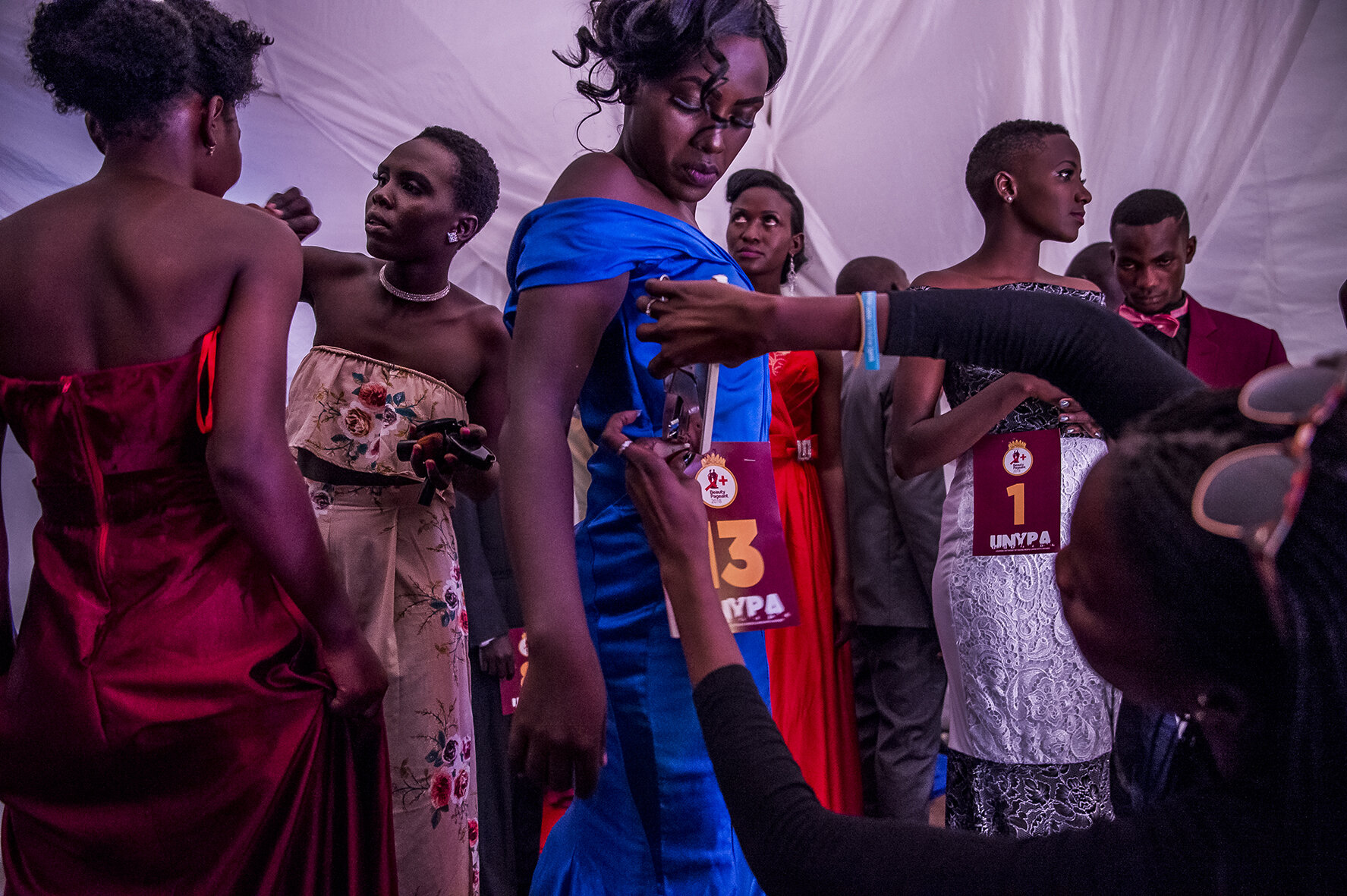
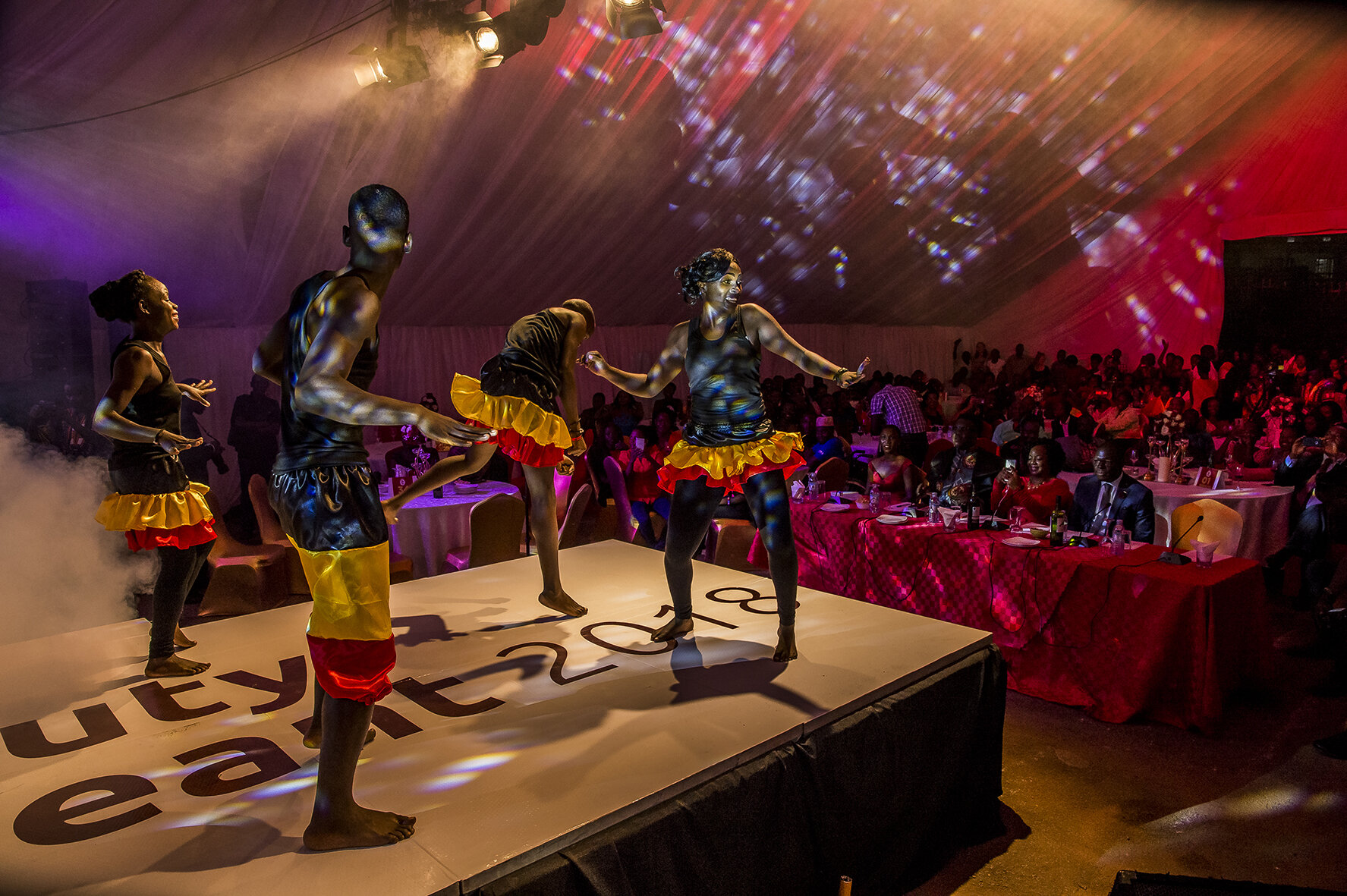
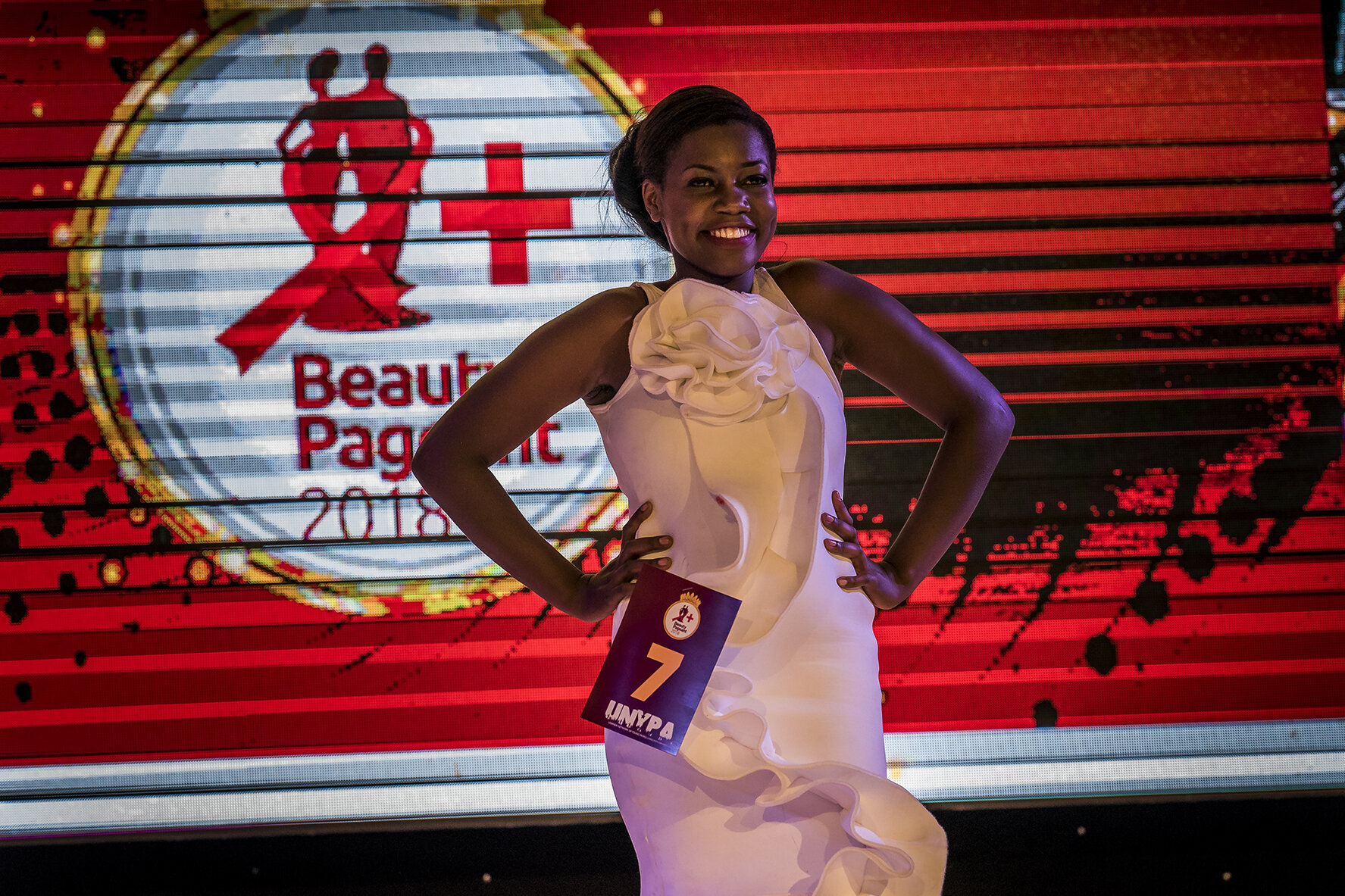
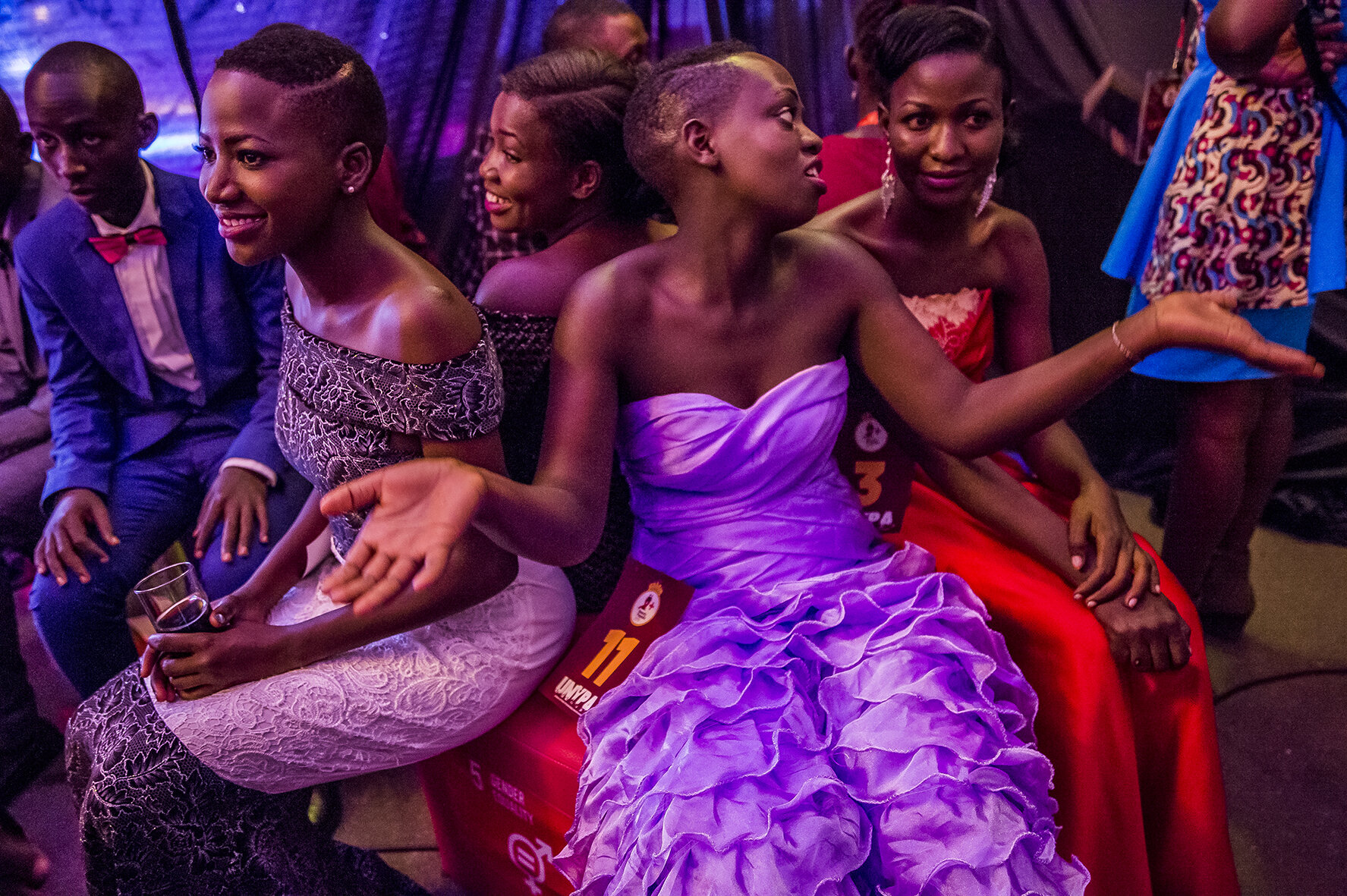
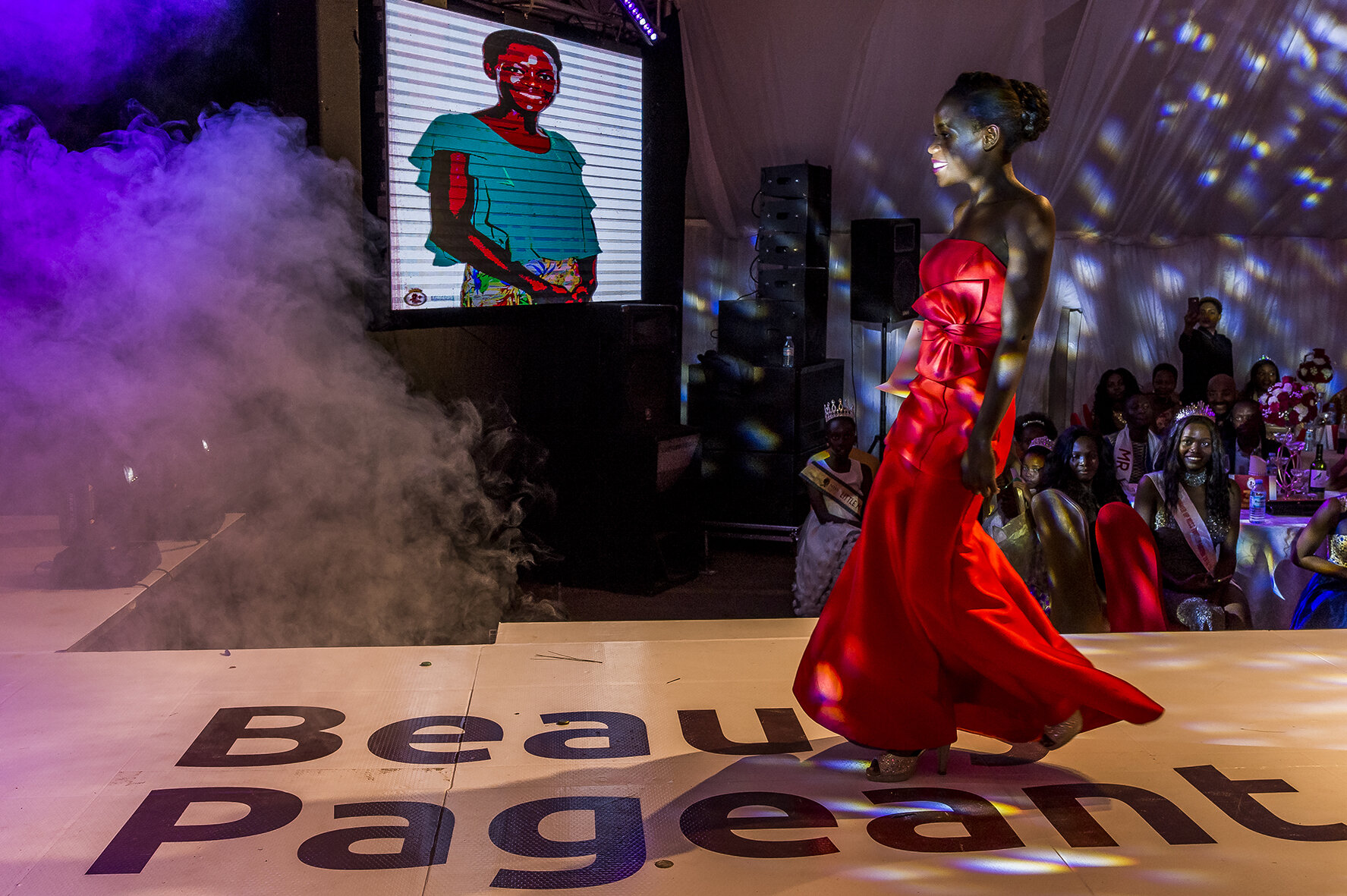
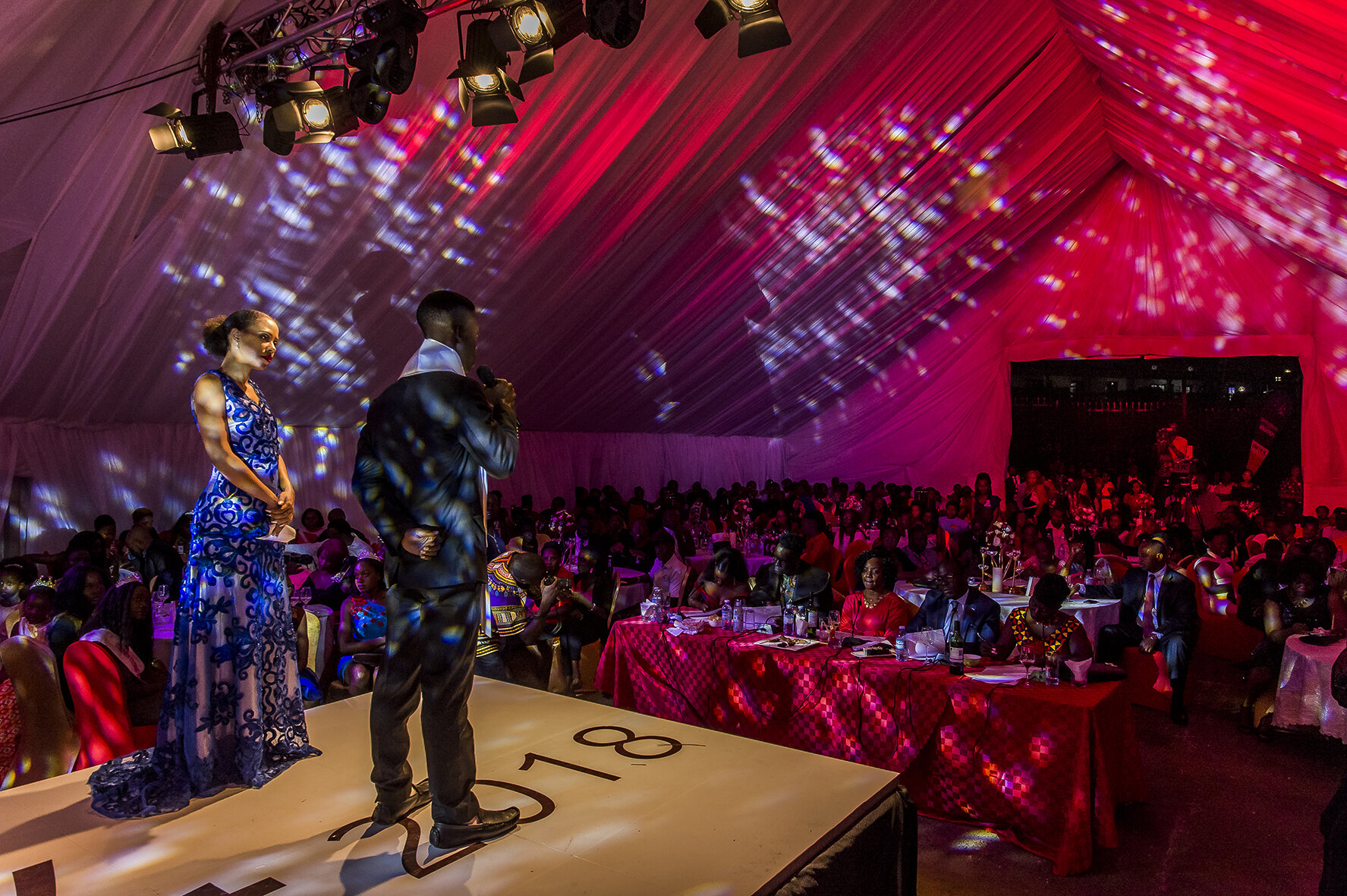
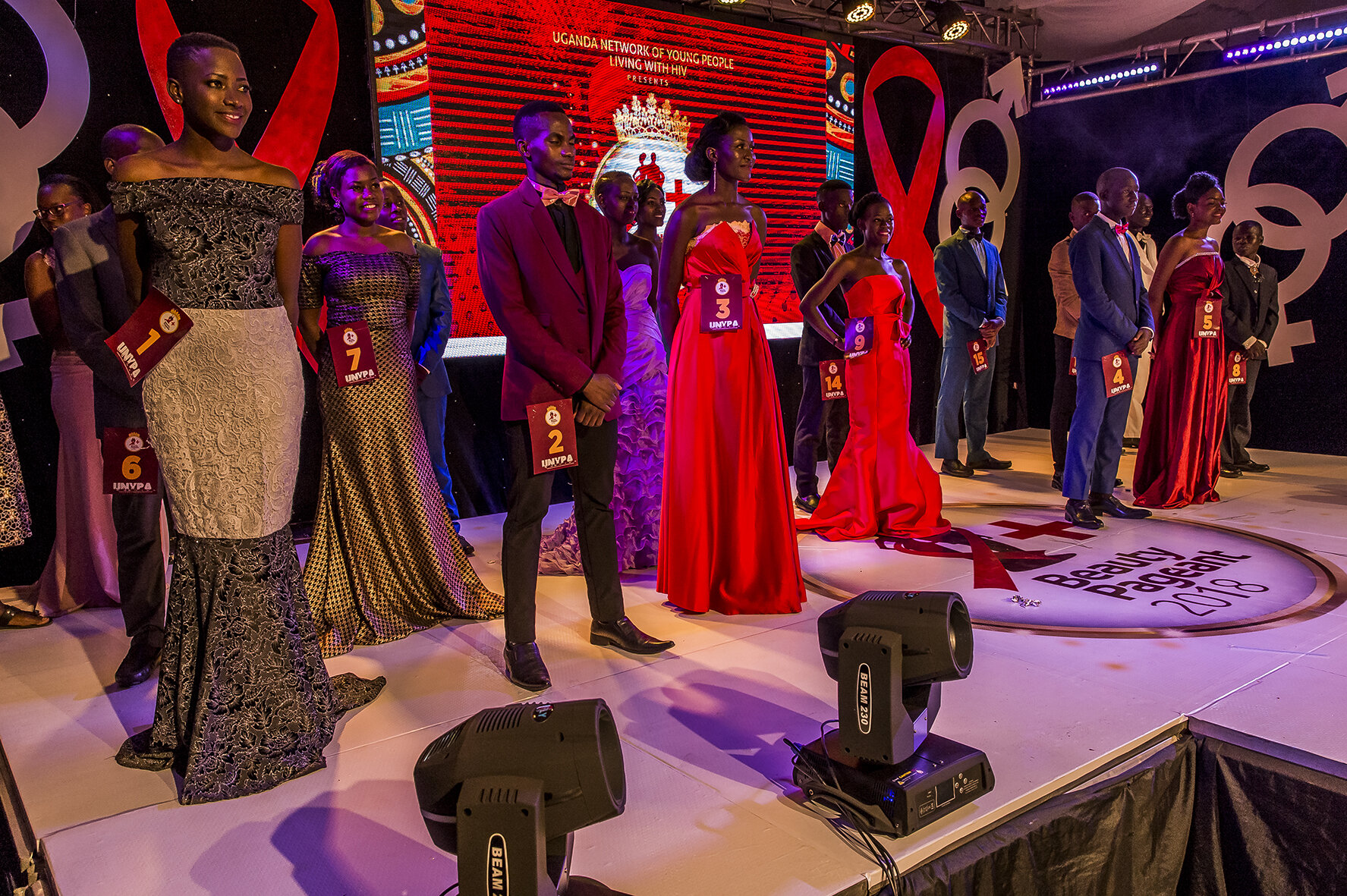
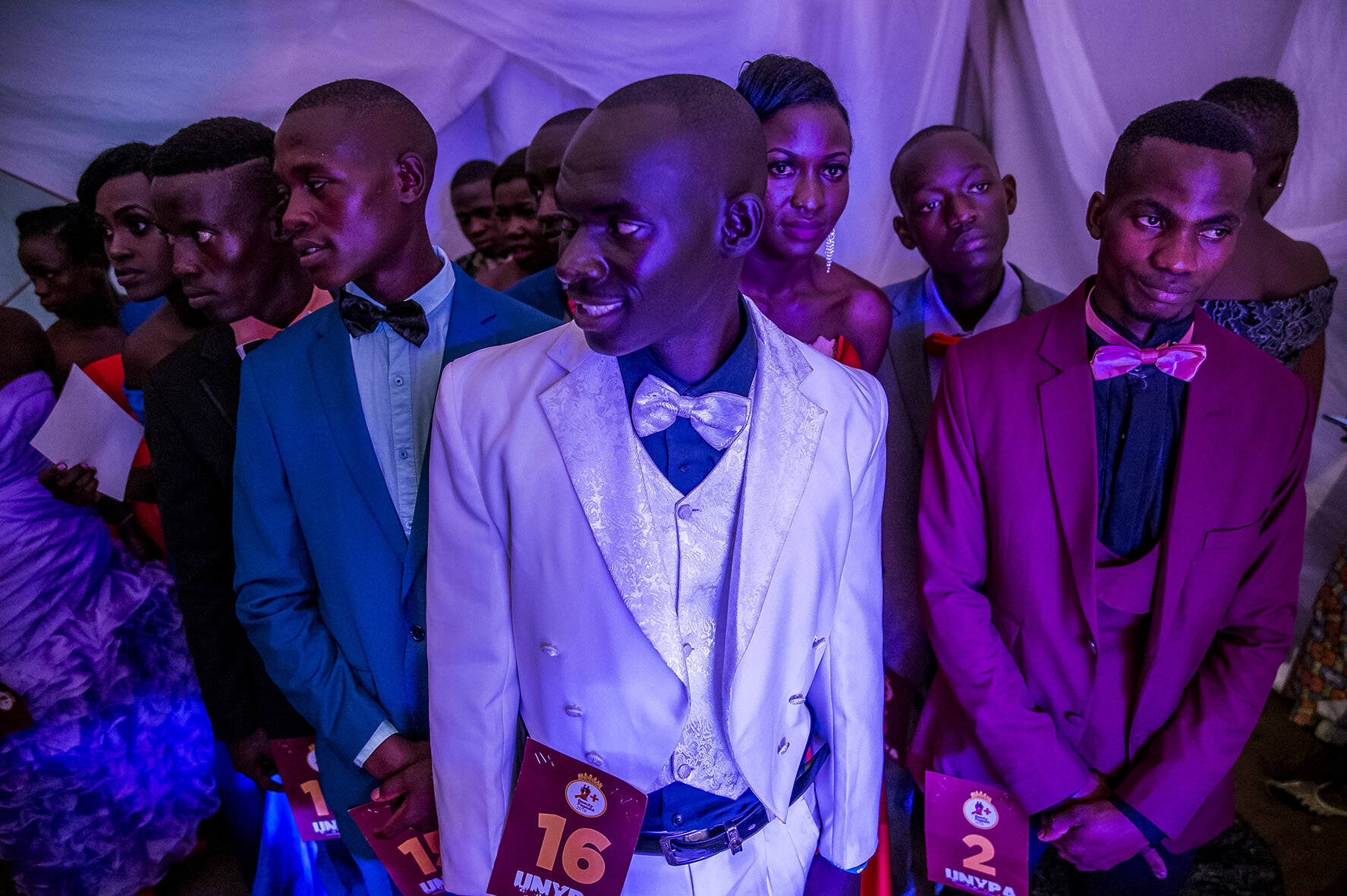
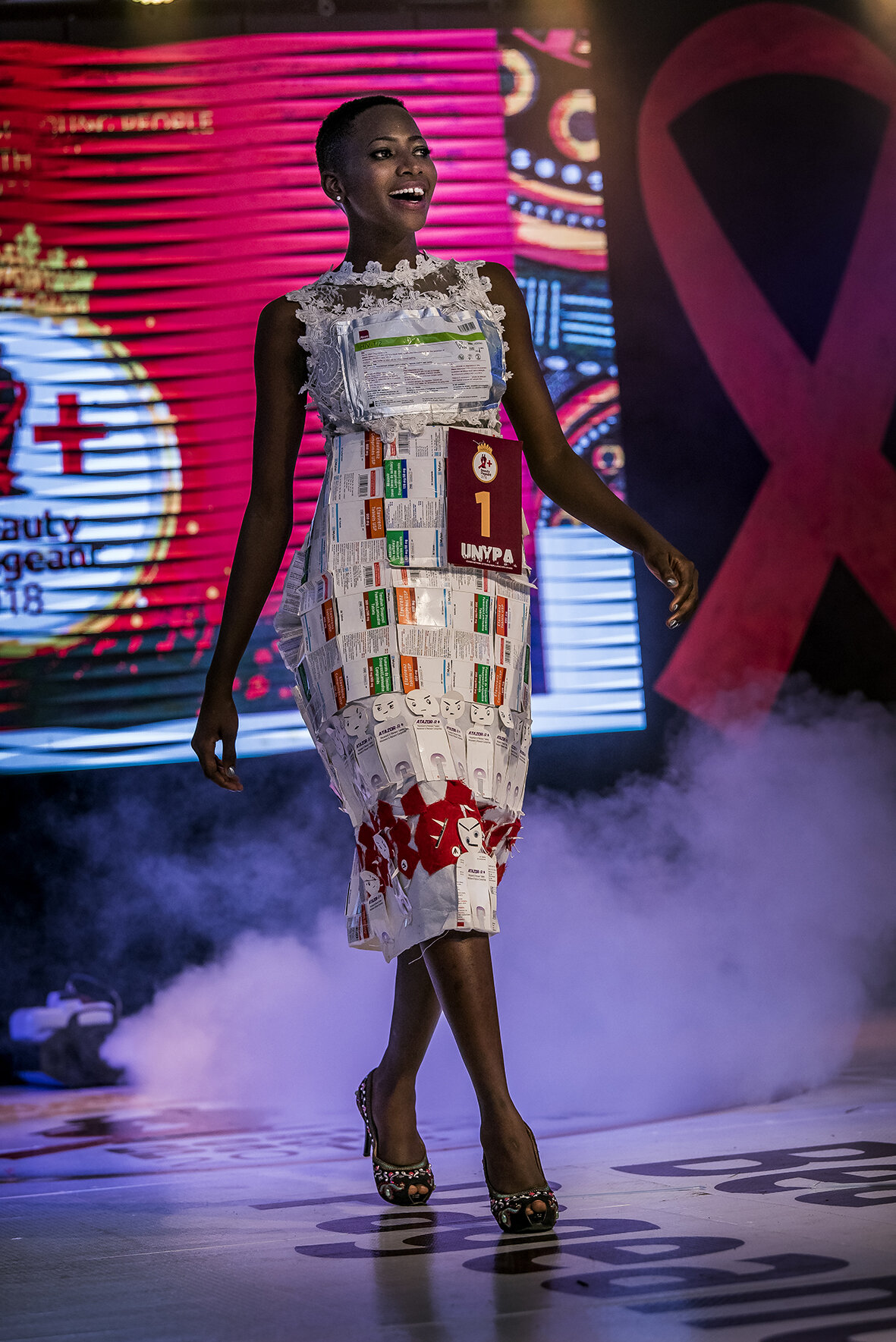
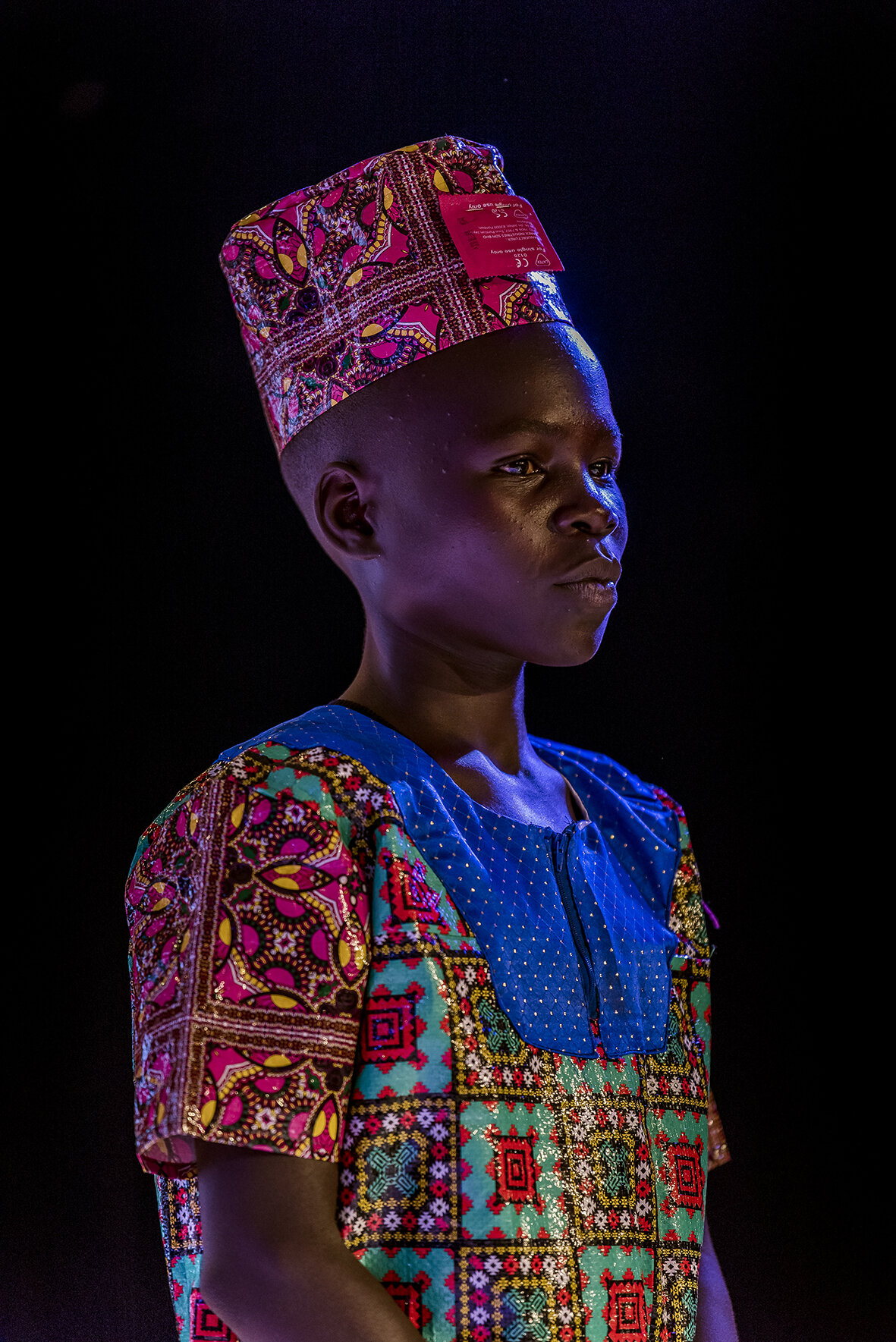
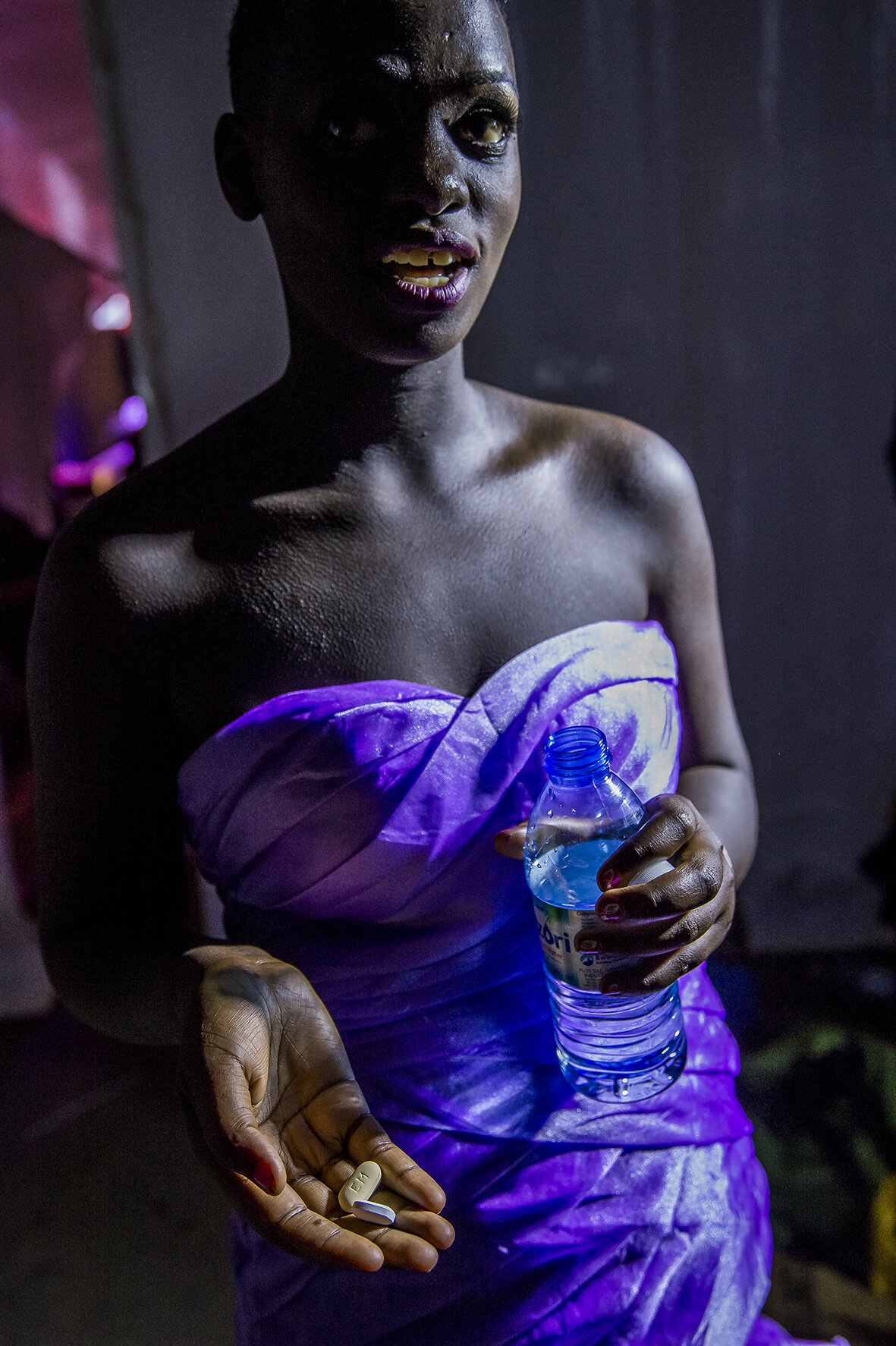
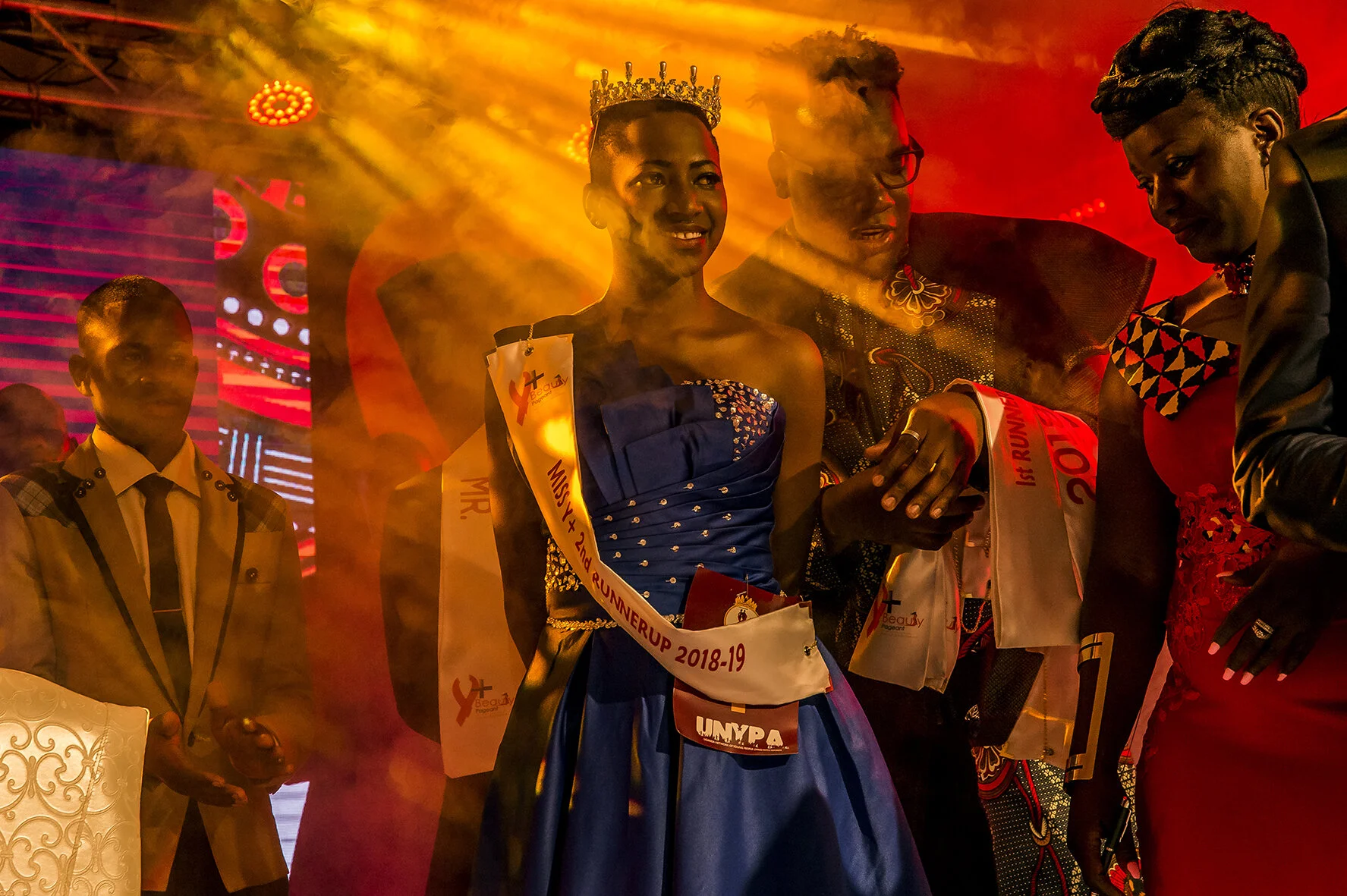
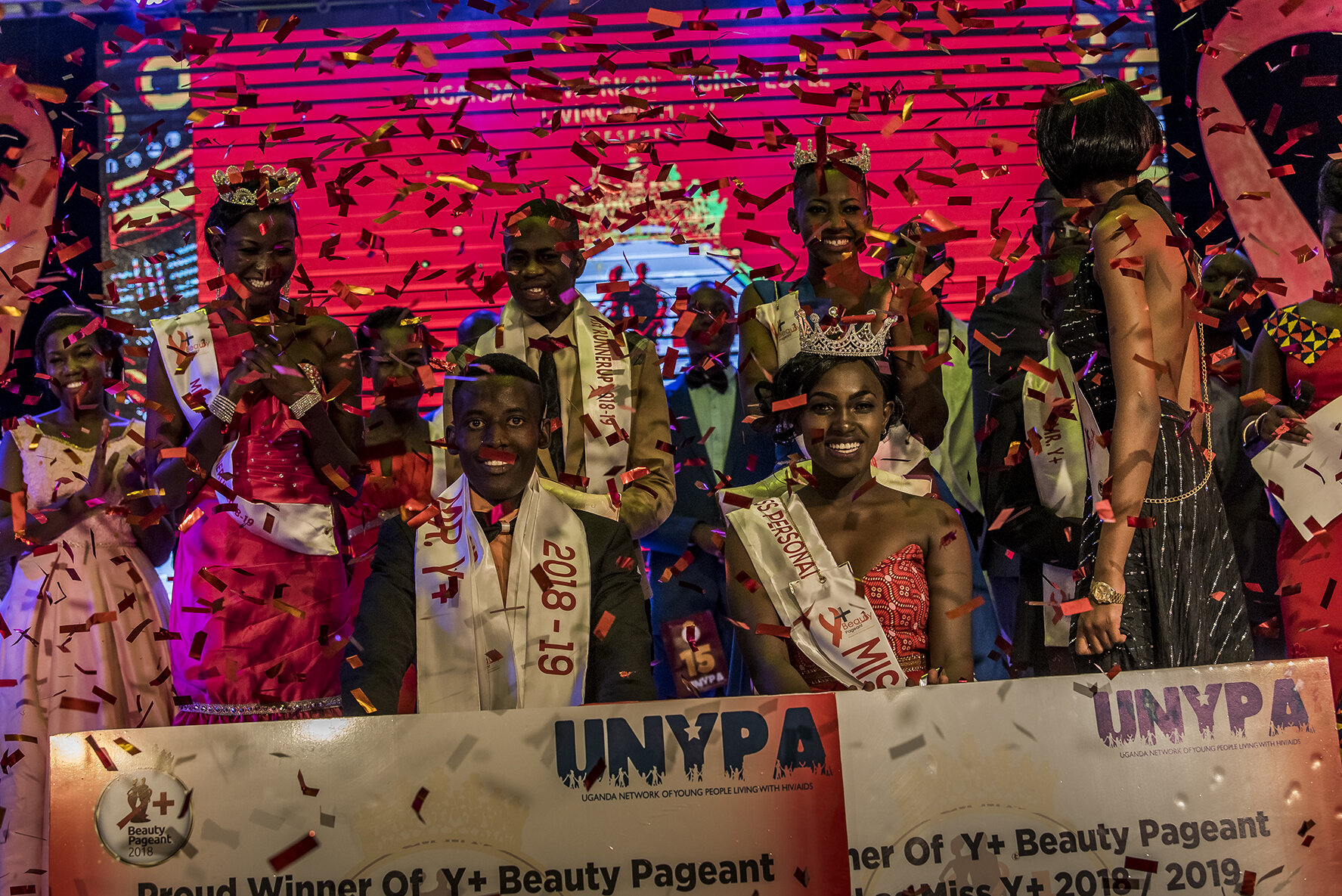
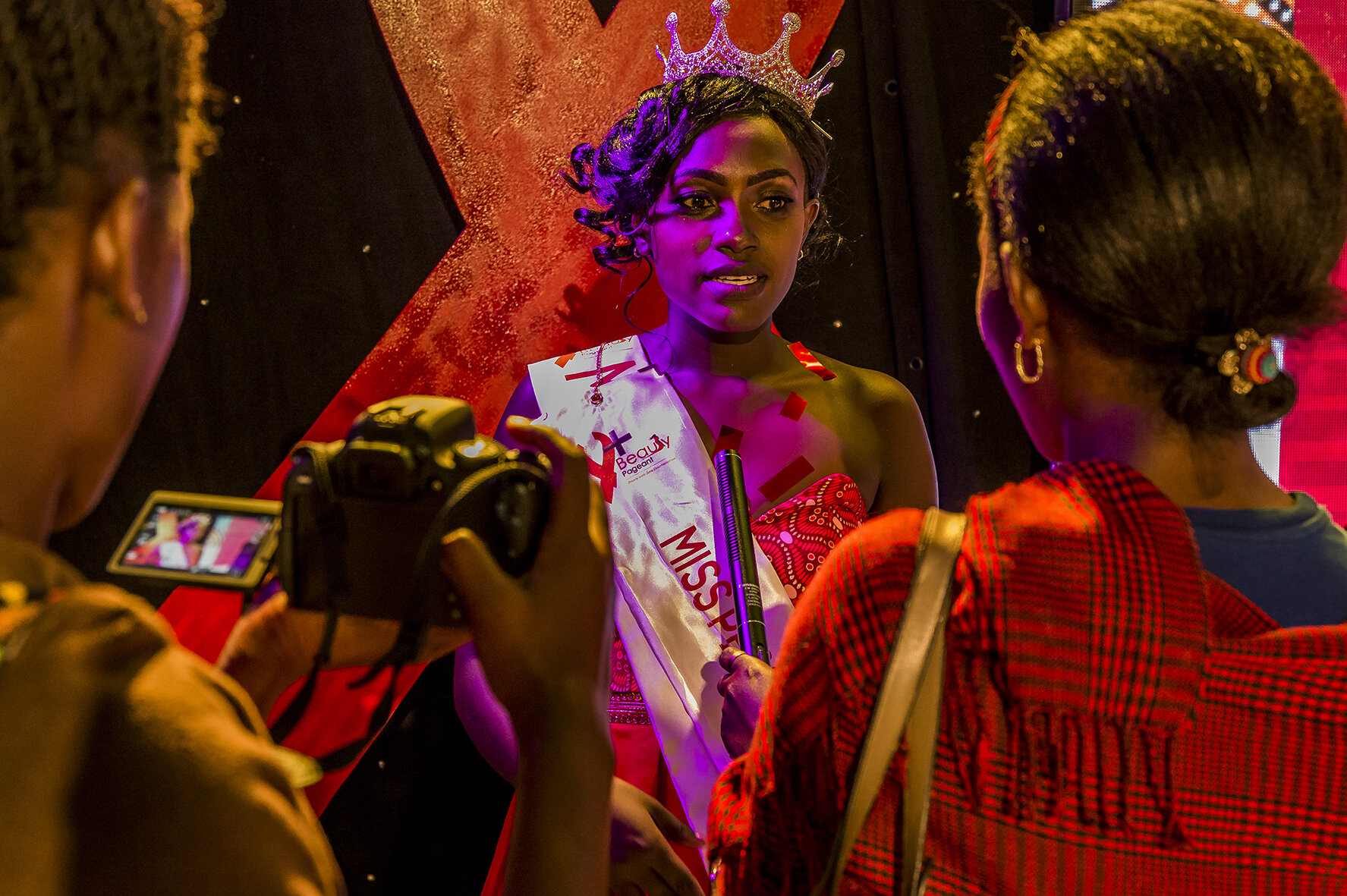
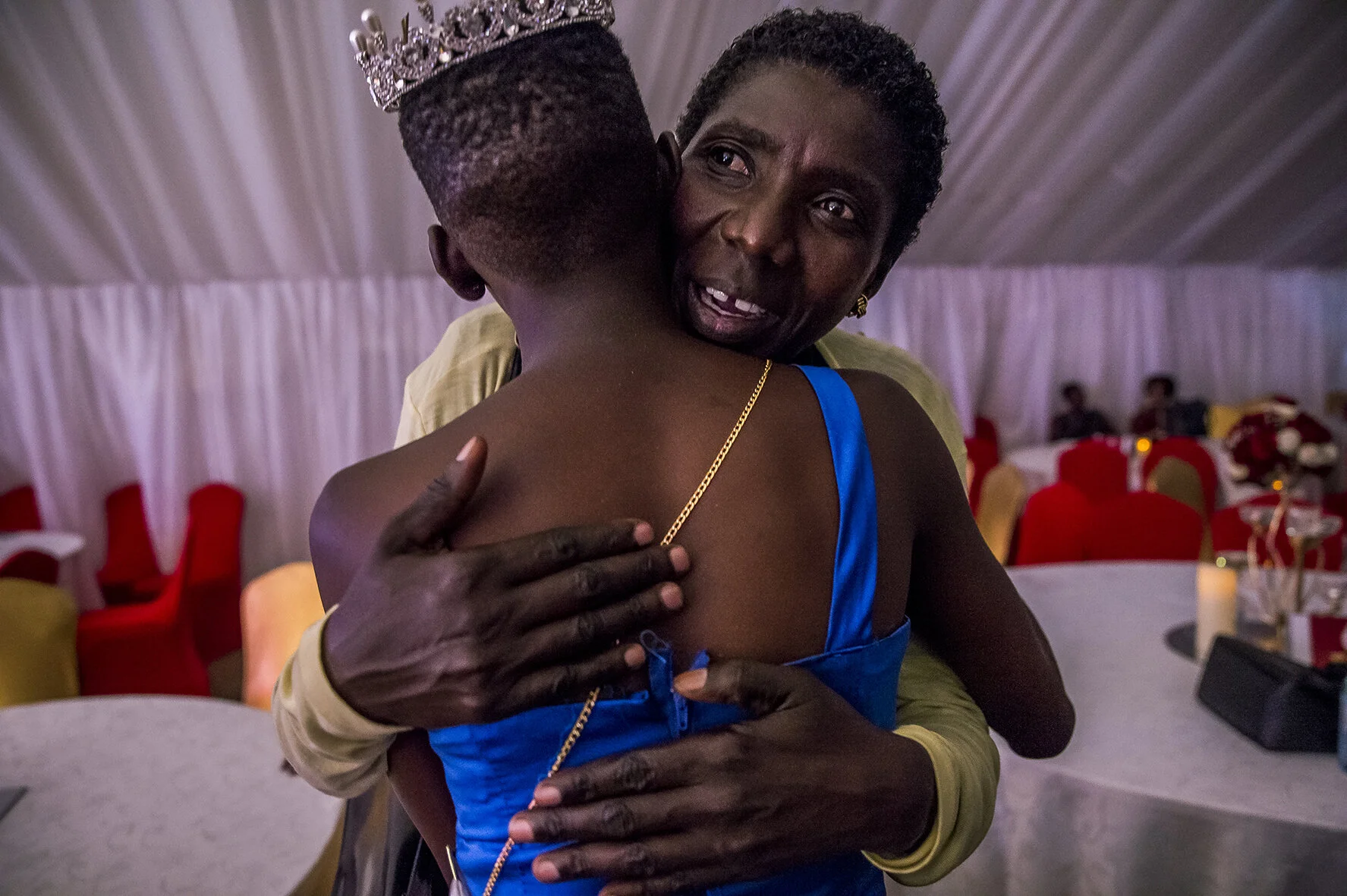
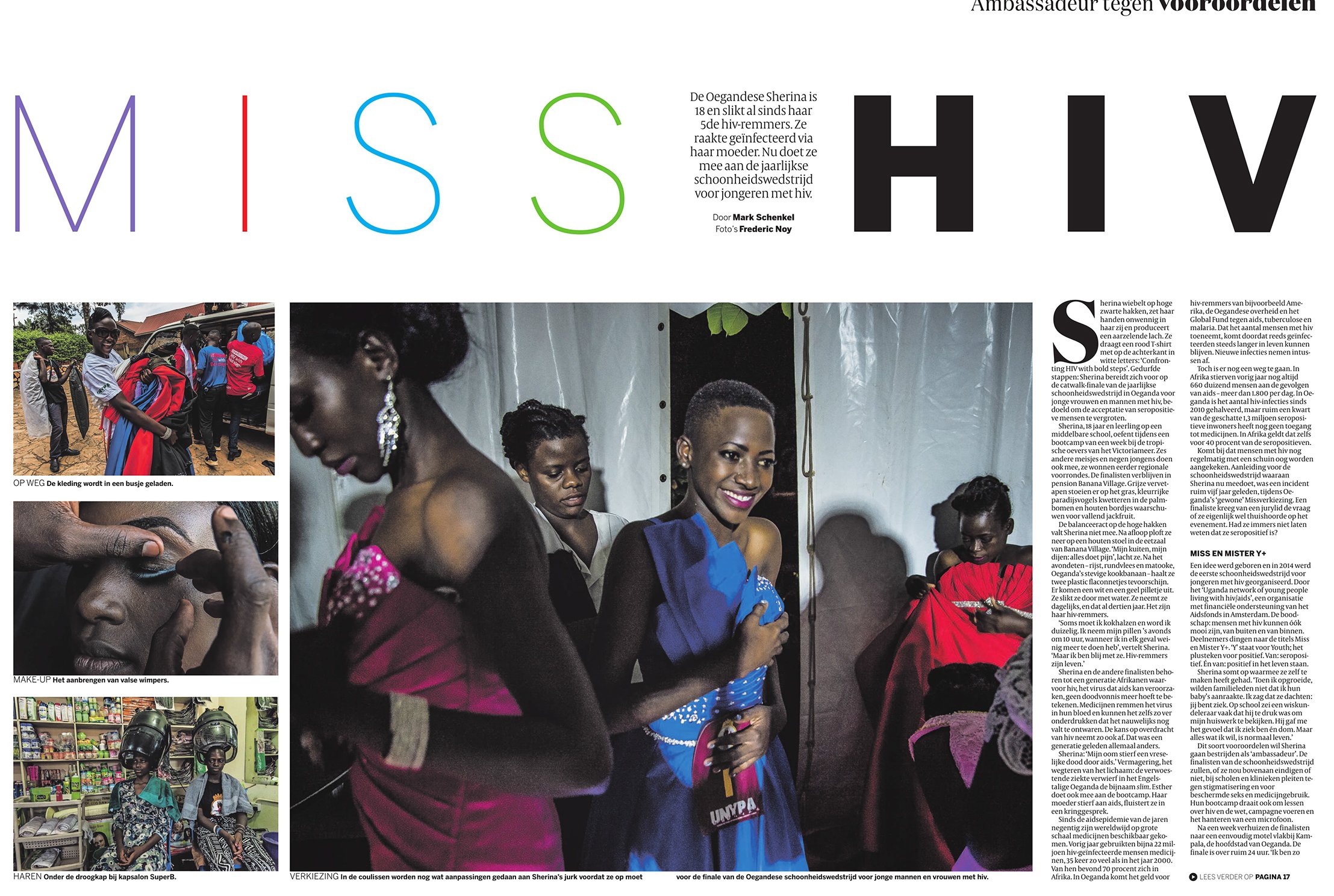
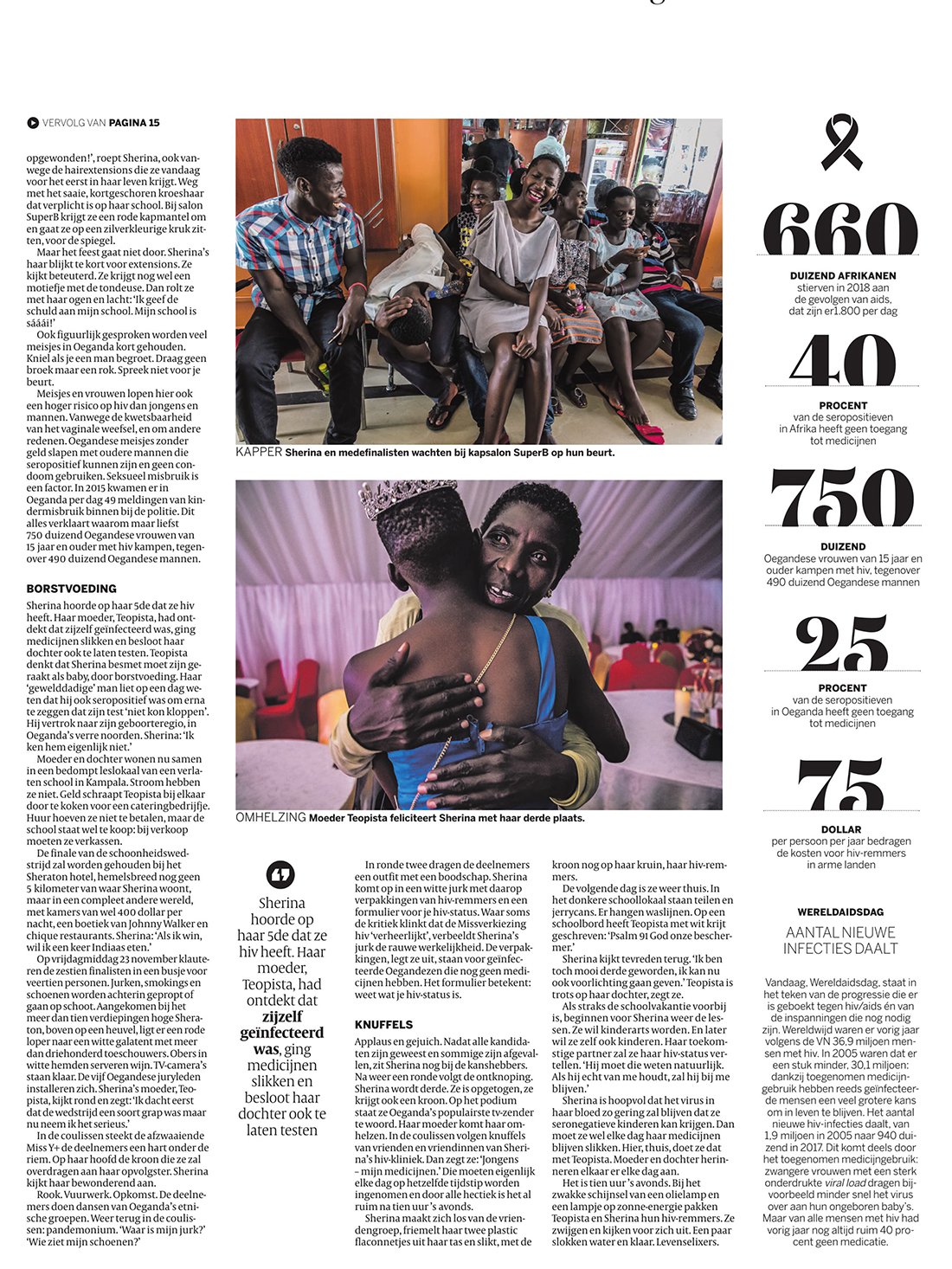

Finalists for the Y+ Beauty Contest informally rehearse the parade opening choreography during a four-day training retreat held at Banana Village, a hotel on Lake Victoria. Vivian Nabanoba, the future winner of the competition (in gray, in the middle) leads the rehearsal. The event will take place in a few days. The message of the Y+ contest is that people with HIV can also be beautiful, externally and internally. Participants compete for the titles of Miss and Mister Y+. “Y” stands for youth and + for positive as HIV positive.

A professional coach expert in fashion shows teaches female finalists how to walk with high heels during a training retreat in a resort on Lake Victoria in Entebbe. The Y+ beauty contest is national. In previous months, auditions were organized in the Ugandan regions to select the candidates who will be decided between in Kampala, in a few days, during an event in a luxury hotel.

Sherina and Hajarah have their hair done in a salon near the hotel, where the 16 candidates spend their last night before the beauty pageant. Among the candidates, they will be the only ones to parade with short hair because the size of theirs does not allow the wearing of extensions. Sherina feels disappointed as she was happy to wear extensions for the first time in her life. Short hair is compulsory in her school.

At Banana Village, a lakeside resort on the shore of Lake Victoria, the nine male candidates qualified for the grand finale of the Y+ beauty contest, are training to adopt a cool model walk, essential when they parade on the podium. The Y+ beauty contest is national. In previous months, auditions were organized in the Ugandan regions to select the candidates who will be decided between in Kampala, in a few days, during the final organized in a luxury hotel.

In the Super B hair salon, in the area of the hotel where the contestants will spend the last night before the competition, a hairdresser is doing a shampoo for a candidate while some males candidates are waiting for their turn.

The female candidates try on their outfits during the final fitting and adjustment session, the day before the final, in a common room adjoining the hotel where they spend the night. Ugandan girls and women face a higher risk than boys and men of contracting HIV. Poor Ugandan girls sleep with older men who may be HIV positive. Sexual abuse is also a factor. In 2015, 49 reports of child abuse per day were received by the Ugandan police.

In a common room adjoining the hotel where the sixteen Y+ candidates spend their last night before the competition, the candidates try their outfits allowing a seamstress to make the last modifications.

Male candidates put on their suits during the adjustment and fitting session the day before the competition in a common room adjoining the hotel where they spend the night before the final.

The day before the competition, during the penultimate fitting session held in the ballroom of the small hotel where the candidates spend their last night, a contestant waits for a seamstress to finish the final adjustments of one of her outfits.

The sixteen candidates load their outfits into a mini van designed for fourteen people who will transport them to the Sheraton hotel, the grand hotel in the center of Kampala where the competition is organized. Dresses, tuxedos and shoes will be stuffed in the trunk or kept on the knees.

Two hours before the beginning of the final, under the eyes of the boys' coach, the sixteen stressed candidates carry out a final set-up on the stage where the beauty contest will take place, in a luxury hotel in the center of Kampala. Seven girls and nine boys have won regional qualifications the previous months and are participating in the final.

Behind the scenes, a makeup artist is touching up the face of Vivian Nabanoba, candidate and future female winner of the Y+ beauty contest. She will then become a Y+ ambassador for a year. She will go to schools and clinics to talk about stigma, safe sex and protective drugs.

One of the nine male contestants of the beauty pageant is a pastor. Backstage, before the opening choreography executed by the sixteen contestants, wearing ponchos in the colors of the Uganda flag (Yellow, black and red), he leads a prayer (in red) while the others reflect. In Uganda, 750,000 Ugandan women aged 15 and over suffer from HIV, compared to 490,000 Ugandan men.

Behind the scenes, a make-up artist is touching up the makeup of a candidate, while a dresser staples the time number on the waist of Vivian Nabanoba’s dress, the future winner of the competition. Besides walking away with a full year scholarship financed by Uganda Network of Young People Living with HIV & AIDS (UNYPA), the organizing NGO, the winners of the beauty pageant must use their status to contribute to the fight against the stigma attached to the virus by participating during the year of their reign, at many events and by demonstrating through their activism that it is possible to rub shoulders with HIV-positive people and lead a normal and active life.

The beauty pageant begins with a choreography bringing together all the candidates, boys and girls, in front of a packed marquee (gazebo). They wear all the colours of the Ugandan flag: black, red and yellow. The members of the jury are seated in the foreground behind a long red table.

A female contestant in the Y+ beauty contest emerges from backstage, before setting off on the podium at the Sheraton hotel, dressed up in an evening dress, in front of more than 300 spectators. The first edition of the competition took place in 2014. In 2019, the 4th edition puts in competition, 16 candidates of which the youngest is 15 years old and the oldest, 24.

Backstage at the 4th edition of the annual beauty pageant for young people living with HIV in Uganda, an event to fight social stigma. A group of contestants wait for their catwalk. They all are HIV positive. Second from left is Sherina, 18 years old who knows that she is HIV positive since she is 5 years. She has been infected by her mother through breath feeding. The Y+ competition exists because of an incident that occurred five years ago. In a "regular" Miss election in Uganda, a jury member asked a runner-up if she actually belonged to the event. Didn't she say she was HIV positive ?

A candidate wearing an evening dress makes her way on the podium before the five Ugandan jurors. This is one of the beauty contest tests. On the giant video screen, her portrait is displayed while in the room a mistress of ceremonies presents her.

Hillary Niwamanya, a candidate, future male winner of the edition, answers the questions of the 5 jurors, after having qualified for the second round of the competition. The Y+ beauty contest targets young HIV-positive people. The winners must use their status to contribute to the fight against the virus by participating during the year of their reign, at many events and by demonstrating through their activism that it is possible to rub shoulders with HIV-positive people and lead a normal and active life.

After several appearances on the stage in several outfits, the candidates standing in the back of the stage are waiting for the finalists' names to be called.

Candidates watch from behind the scenes as their colleague parade, ready to appear at the signal of a stage manager.

During the final events, Sherina compete in an outfit she made during the week of preparation and retreat. The only requirement for this event is that the costume must carry a message. Sherina appears in a white dress made of HIV retroviral packaging and an HIV status form. Her dress symbolizes raw reality. The packages, she explains, are intended for infected Ugandans who do not yet have drugs. The form means: 'Know your HIV status'.

The young Acholi ethnic candidate from northern Uganda is wearing the costume he made for the message test. On his cap, a condom is stapled, reminding to the audience of the need to protect themselves during sexual intercourse in order not to contract or spread HIV.

From two plastic bottles carried in her bag, Hajarah draws two long tablets. At 10 p.m. every day, she has to take her antiretrovirals. That day, she does it backstage during the beauty pageant, before the results are announced.

At the end of the competition, Sherina got the second runner up price. Delighted, as she also receives a crown. Such an achievement when she remembers what she had to deal with because of her HIV status. "When I was growing up, the family members did not want me to touch their babies, I saw that they thought: " you're sick" . At school a math teacher often said that he was too busy to see my homework. He made me feel sick and stupid, but all I want is a normal life. »

Surrounded by their runner-up, under a shower of confetti, Hillary Niwamanya and Vivian Alice Nabanoba are crowned Mister and Miss Y+ of the 2018/2019 edition.

Moments after her coronation as Miss Y+ 2018/2019, Vivian Alice Nabanoba answers an interview for a local television in Kampala. Besides walking away with a full year scholarship financed by Uganda Network of Young People Living with HIV & AIDS (UNYPA), the organizing NGO, the winners of the beauty pageant must use their status to contribute to the fight against the stigma attached to the virus by participating during the year of their reign, at many events and by demonstrating through their activism that it is possible to rub shoulders with HIV-positive people and lead a normal and active life.

Sherina's mother, Teopista, congratulates her daughter for her third place. Sherina learned at age 5 that she had HIV. Her mother, Teopista, had discovered that she herself was infected, started taking medication and decided to have her daughter tested. Teopista thinks that Sherina must have been infected as a baby by breastfeeding. Mother and daughter now live together in a cluttered classroom in a closed school in Kampala. They have no electricity. Teopista manages to get some income by cooking for a catering company. They do not pay rent, but the school is for sale: they have to move sooner or later.